INTRODUCTION

Chardonnay and Pinot Noir are just about two of the most famous classic grape varieties in the world. Both hail from Burgundy and are responsible for two of the world’s most magical wine styles – Pinot Noir for haunting sensuous reds and Chardonnay for stunningly rich, honeyed, nutty, oatmealy whites. Yet isn’t it strange that neither red or white Burgundy trumpets the grape names on the label?
So what is a grape, then? Well, it’s juice and flesh, obviously. It’s skin, obviously. It’s pips, and I suppose it could be the stalks as well. And then what? And then everything, that’s what.
If we have any interest in wine and in flavours, we have to be interested in the grape variety itself. If we have any interest in how a wine matures and changes with age, we have to know about the potential of the particular grape. If we care about the style of a wine, whether it should be sweet or dry, fizzy or fortified or still, each different grape variety’s peculiar talents will be of prime importance. Do we like the flavour of oak barrel aging in our wine? Some grapes take to oak, again some don’t – it’s vital to know which ones love the kiss of oak and which ones loathe its hot embrace. And are we fascinated by how completely different wines taste when they come from different countries and from different regions within those countries? Without the consistent character of each different grape variety to use as a measuring point, mere comparison of place would be meaningless. However far we delve into all the things that influence the flavours of our wine, it all comes back to the grape.
I mean, think about it. I give you a glass of pale golden green wine. It’s got a wonderful pungent scent of gooseberry and passion fruit and lime. You taste it and the acidity crackles against your teeth, the exhilarating attack of citrus fruit scours your palate clean and makes your mouth drool with desire for food. Who made the wine? No idea. Where does it come from? It could be the Loire Valley in France. But it could also be South Africa or Chile, it could be Spain or northern Italy. And it could certainly be New Zealand. So. The four corners of the earth, really. But the grape variety? When the wine smells and tastes like that, you know it is Sauvignon Blanc. The unique, brilliantly recognizable character of the wine is down to the grape variety – Sauvignon Blanc – above all else. It is refined by the relative talent of the men and women who grow the grape and vinify the wine. It is modified or intensified by the local conditions under which it grows. But the core of the flavour comes from the grape.
Now, Sauvignon Blanc is a very dramatic grape. But so is Viognier with its powerful scent of apricot and mayblossom. So is Gewürztraminer with its explosion of musky rose petals and lychees. So is Muscat with its overpowering aroma of hothouse grapes. Riesling is more subtle, but the unmistakeable balance of high acidity with floral notes and citrus fruit is unique to the grape. Chardonnay’s nutty, oatmealy ripeness is created with the help of oak barrel aging, but no other grape achieves quite that taste, however similarly you treat it, wherever it is grown.
Red wine grapes are frequently less outspoken, and just at present the obsession with overzealous use of new oak to age wines is spoiling the thrilling individuality of many grapes’ flavours – but good varieties still shine through. Tannic sturdiness and blackcurrant fruit mark out Cabernet Sauvignon in a way no other grape can replicate. The ethereal scent and strawberry/cherry fruit of Pinot Noir, the damson fruit and violet perfume of Malbec, the sour cherry and herbal rasp of Sangiovese, the brilliant chocolate and smoky black plum blast of Shiraz – all of these experiences and many more are above all else due to the particular characteristics of the grape variety.
It is remarkable how, over the years, grapes seem to have been relegated to a subordinate role in wine books when they are so evidently of such massive importance. Well, one of the reasons has to be that until the advent of modern ‘New World’ winemaking techniques that allow the winemaker to pinpoint the potential flavour of the grape and then maximize it, I suspect that few people – winemakers, wine writers and wine drinkers all – actually had much idea of what a grape variety was supposed to taste like. It was easier to say that a wine’s particular taste derived from where it was grown, that it tasted of what the French call ‘terroir’. Indeed, the wines often did have a minerally or earthy flavour which probably did emanate from the vineyard and from old-fashioned winemaking, rather than the actual grape itself. That’s why, until recently, many experts and critics were obsessed with the minutiae of a wine’s birthplace rather than its chief component – the juice of the grape itself.
But when the New World producers brashly barged their way through into our wine consciousness, everything changed. The Australians and Californians, New Zealanders, South Africans and Chileans didn’t have much of a story to tell when it came to the traditions and historical importance of their vineyards – many of these selfsame vineyards had only just been planted. The one story they could tell, and the one their ultra-modern winemaking allowed them to tell, was that of the grape itself and the flavour it imparted to the wine. Varietal labelling – labelling a wine according to its grape variety – was one of the most revolutionary moves in wine of recent times, a brilliant stroke of democratization, opening up the wonderful world of flavour to millions previously bamboozled and excluded by the obscurity and unhelpfulness of most wine labels. It allows all of us to make informed choices about what we like and don’t like, and makes it so easy to extend our knowledge and experience and pleasure. The grape variety blazes the way: everything else follows.
And there’s never been a time when a book recognizing grape varieties as the most important factor in the flavour of a wine has been needed more. The 21st century has seen an explosion of interest, not just in the main varieties, but in the local grapes of every area that grows wine, the ancient varieties facing extinction, the ones previously thought of as dullards, or as too much trouble to grow. Suddenly we’re interested in all of these. Social media spreads the word in seconds. Winemakers (wherever they are) have no qualms about planting experimental varieties. Indeed, it’s almost a badge of honour to have something unusual and unexpected growing in your vineyard. And always with the objective of creating new, exciting, often unexpected flavours in your wine.
We are now seeing a progression as even the most futuristic of New Wave winemakers begin to search out the special characteristics of different patches of land – a return to terroir, I suppose. So does the grape variety simply become a vehicle for the flavour of place? Well, try planting Muscat or Malvasia or Marsanne in Meursault and see if you capture the compelling flavours of its vineyards. You won’t. Chardonnay is indeed the vehicle for Meursault’s unique personality and indispensable as such. But the grapes’ unique characteristics are just as important as those of the vineyard – and a great deal more adaptable, since they will express themselves in recognizable ways wherever the vine is planted.
Along with this move towards a greater understanding of each vineyard and its potential is a move away from relying solely on the best known grapes. Eighty per cent of the world’s wine comes from a mere 20 grape varieties. We cover all these in great detail, but also examine hundreds more from every corner of the wine world, so that when you’re ready to move out of the comfort zone, this book will be there for you, to encourage, to explain, to lead you on to the fabulous adventure of new flavours, new sensations, new pleasure. The world of wine with the wine grape at its heart – that’s what this book is about.
While planning the project, I realized I simply couldn’t handle it all by myself. I knew I needed someone to work with who was a first class wine intellectual who could shoulder the bulk of the research, make the best of the brilliant, up-to-date and minutely detailed data that we would obtain from every important vineyard area worldwide, and then put masses of often quite indigestible source material into a highly readable form. I also needed someone who, when I was flying off on my frequent flights of fancy, could rap me firmly on the knuckles and say ‘Come on, Oz. Back to earth. This is a serious book of research as much as a joyous celebration of grape varieties in all their multi-flavoured glory’. Well, she didn’t quite say that; she’d have edited out most of the final sentence for a start. But the person who shared in the creation of this book with me is Margaret Rand. And without her talent and determination we’d never have got it done.

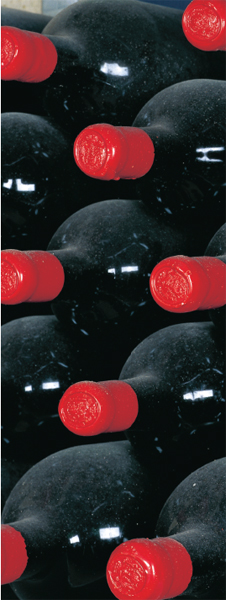
Double magnums stored away in the vintage bottle cellar at Château Canon-la-Gaffelière in St-Émilion, Bordeaux.
THE STORY OF THE VINE
The story of human cultivation of the vines is the story of the spread of civilization and the movement of populations. All cultivated vines – all 10,000 or so varieties of grapevine – are the descendants of wild vines. And while there doesn’t (so far) seem to be an Eve-vine theory, to parallel the way that the study of mitochondrial DNA has hypothesized a single female ancestor for humanity, DNA studies seem to have pinpointed where the first vine was cultivated.
Or at least, they have pinpointed the two most likely places. Southeast Anatolia is one; Transcaucasia the other. The upper reaches of the Tigris and Euphrates rivers, in the Taurus mountains of eastern Turkey, are the favourite candidate. It’s partly the enormous range of cultivated vines native to these regions that give the clue, and partly the close relationships between the DNA of local wild vines (which still proliferate here) and that of the local cultivated varieties. When did it happen? Presumably some while after humans discovered that wine – which will develop naturally, provided that ripe grapes are left in warm conditions for a few days – had an agreeable flavour and could cheer you up after a hard day. Wild grapes would have been plentiful, and would have been a useful part of the diet. From grapes to wine is a very small step.
The step from wild vines to cultivated ones is bigger. Wild vines come in male and female versions; cultivated vines are hermaphrodite. The difference in the shape of the seeds is a useful clue for archeologists trying to determine if the inhabitants of a particular early settlement were cultivating the vine or not; but why should vines make this jump?
A tiny percentage of wild vines, maybe two or three per cent, are hermaphrodite. Hermaphrodite vines would be easier to cultivate and would produce a more certain crop, giving them an obvious advantage. So it is reasonable to assume that hermaphrodite wild vines are the probable forebears of our modern vines. Vines can be cultivated from seed, but every time a berry from an early vine fell to the ground and the seed germinated and took root, a new variety of vine would be born. Some would have found favour with early farmers for their sweetness and flavour and the attractiveness of their wine; others would have been dismissed. It took the introduction of propagation by taking cuttings – in this way, every vine can be identical to its parents – for the cultivated vine to begin to squeeze out and dominate its wild family relations. Now we are on the way to today’s 10,000 or so known varieties. How did Vitis vinifera come to be the chosen species? Well, probably a good old Darwinian process of its wines tasting better.
Surely humans in different parts of the globe would have discovered the same sort of thing independently? Quite possibly; but at the moment it looks as if other centres of early vine cultivation – the Iberian Peninsula was one, as was Sardinia – were not starting from scratch, because there doesn’t seem to be any DNA relationship between early cultivated vines here, and wild ones.
Putting a date on the first cultivation of the vine, or the first wine, is a matter of guesswork at the moment, or romance. There is evidence of both wild and cultivated vines in sites dating from the Neolithic era (8500–4000 BC) in southeast Anatolia and Transcaucasia. The remains of liquid containing tartaric acid, identified by infrared spectrometry, have been found in Neolithic settlements from the sixth millenium BC in northern Iran; the presence of tartaric acid is a certain pointer to grapes. The liquid had been in stoppered jars, laid on their sides, and terebinth tree resin had been added as a preservative. Would they have gone to this trouble just to preserve grape juice? Maybe. But would they have been able to stop the grape juice beginning to ferment? That’s what grape juice will always do, if you don’t stop it, so isn’t it more likely that these stoppered jars held this weird and wonderful nectar called wine, the bringer of joy and laughter and good times? If so, who was first? Was it a mistake that turned out brilliantly? Well, an awful lot of the seminal moments in the development of all alcoholic drinks are ‘happy mistakes’. And the chance fermentation of some wild grape juice was probably the first of the lot, lost in the mists of alcoholic time.

This copy of a wall painting from the tomb of Kha’emwese at Thebes, c.1450 BC, is both a technical aide-mémoire, ensuring that the departed will be well supplied with wine in the next world, and perhaps an expression of pleasure in all the different stages of the cultivation of the vine and the making of wine. For us it is also invaluable documentary evidence of how grapes were grown and wine made in an early but extremely sophisticated civilization. The viti- and vinicultural techniques shown here are far from primitive, even if the wines that resulted might not be to our modern taste.
It really shouldn’t come as a surprise that the grapevine was first cultivated around the headwaters of the Tigris and Euphrates. The Fertile Crescent was where many ‘founder crops’ were first cultivated, those from which agriculture throughout the world is derived: chickpeas, lentils, rye, peas, emmer and einkorn wheat come from here. As do languages: all the Indo-European tongues which dominate Western European culture – and consequently much of the rest of the world – have been shown to have originated here. To say that wine and the vine are part of the warp and weft of human civilization is not an exaggeration.
Vitis vinifera and wine
All vines belong to the genus Vitis, which in turn belongs to the Vitaceae (formerly Ampelidaceae) family (see chart right). The Vitis genus includes around 60 species and is generally divided into two sections: Euvites, which contains nearly all the American, Asian and European vine species, including the European wine vine, Vitis vinifera; and Muscadiniae, which is sometimes considered a separate genus. This book focuses on Vitis vinifera; other species of vine, like Vitis labrusca, Vitis riparia or Vitis berlandieri, are important to wine largely because they provide, either directly or by way of crossings, the rootstocks on to which Vitis vinifera vines are grafted. (See here.)
There are also hybrids: vines whose parents are of different vine species, as opposed to crosses, which have both parents of the same species.
The usual object of breeding hybrids is to combine some genetic advantage of a labrusca or rupestris vine with the better wine flavours obtained from vinifera: non-vinifera varieties give pungently scented wine often described as ‘foxy’, though the aroma is in fact more reminiscent of mayblossom or nail varnish. Maybe that’s why winemaking was slow to catch on among the early settlers in North America whose native vines were all non-vinifera. But these vines may have resistance to disease (particularly phylloxera) or cold: hybrids of American vines with vinifera are widely planted in many more northerly states in the USA because vinifera vines find it difficult to withstand the winters. Seyval Blanc, a so-called French hybrid (French hybrids are a group of hybrid vines bred in France in the late 19th and early 20th centuries in an attempt to find a solution to phylloxera), was much planted in England until the focus of English growers changed to sparkling wine.
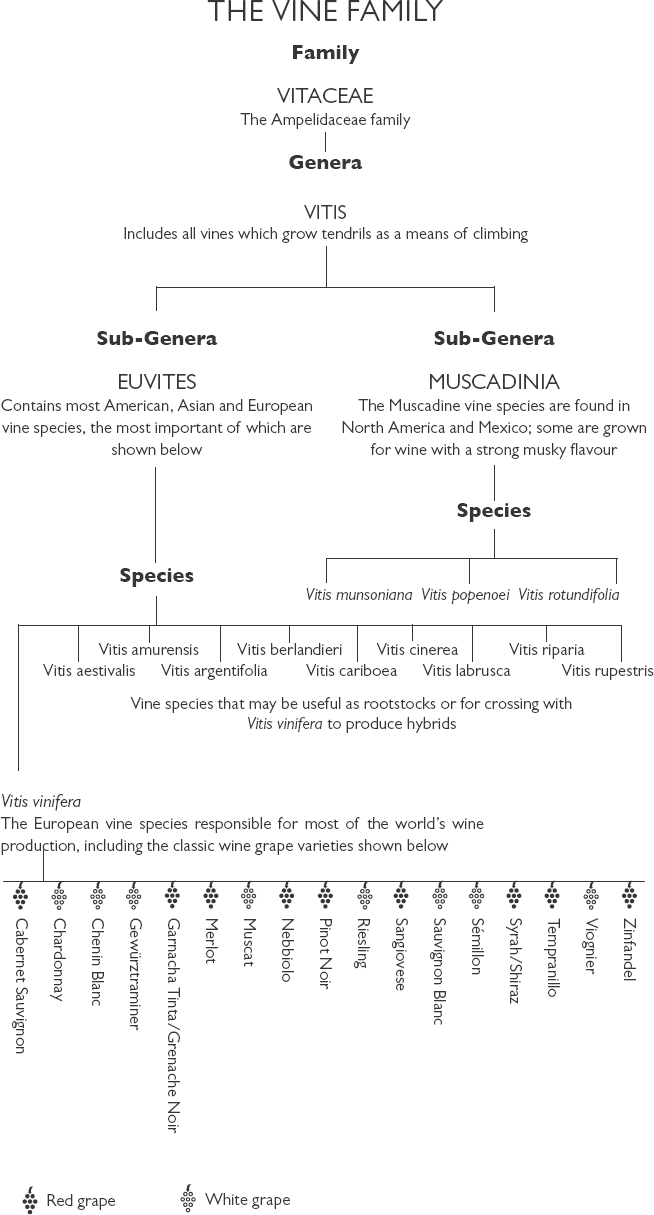

These look more like olives than grapes, but in fact they’re a species of wild vine which Warren Winiarski of Stags Leap Winery in California unearthed on a fact-finding trip to Tajikistan in an attempt to shed light on the development of Vitis vinifera as a species..
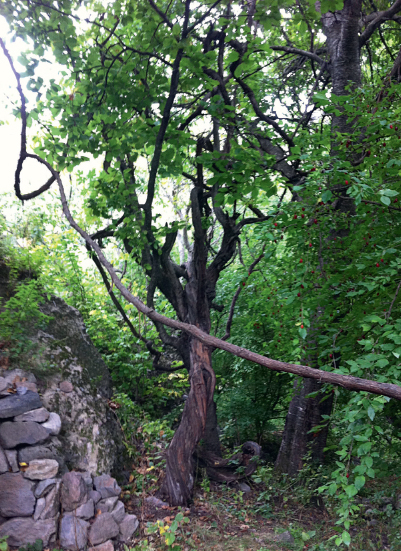
A 400-year-old tree vine of the White Horse Breast variety. No, I‘d never heard of it either, but the ancient vine lands are full of survivors like this, and each one might have a fascinating story to tell, or part to play in the evolution of modern vines. This one is in the Samtskhe-Javakheti region of Georgia.
Hybrids are becoming increasingly sophisticated. There are some now being bred at research stations in Germany that are said to produce wine indistinguishable from the wine of certain vinifera varieties. These latest breedings involve not simply a crossing of an American vine with a vinifera vine, but numerous back-crossings to stabilize the European character. There is one, for example, that is said to be very close in flavour to Pinot Blanc, but which has no Pinot Blanc genes; another is said to be indistinguishable from Riesling, and does have some Riesling somewhere in its ancestry. The best red hybrids resemble Merlot, with good colour, low acidity, and blackberry-cherry fruit.
At the moment hybrids are not permitted for the production of quality wine in the European Union. And anyway, what the world seems to want at the moment is older varieties, preferably ones that are almost extinct, and can be rescued and propagated from three scrubby old vines growing in a corner of an untended vineyard 10km (6 miles) from the nearest road. The speed at which old varieties are being rediscovered is astonishing: most, truth to tell, were probably growing unacknowledged in old mixed vineyards, and not all are wonderful. Some will undoubtedly prove to be genetically the same as other varieties grown elsewhere; some may turn out to be missing links in stories of genetic relationships which are still incomplete. Ten years ago, the story of the vine seemed to be shrinking down to a tail-end of popular varieties, supplemented by new crossings; now we’re rediscovering where we’ve come from.
But some just might completely transform our experience of what is possible in the spectrum of flavours. The guys who first planted the remote Waitaki area in New Zealand’s South Island with vines said the flavours were so different from what had gone before, it was as if they’d discovered a new colour.
VINES TODAY

To you, me and most growers – and indeed to every bureaucrat in charge of enforcing wine laws – Pinot Noir (left) and Pinot Gris (right) are different varieties. Try putting Pinot Noir on your label when you used Pinot Gris, and you won’t get far. Yet to a geneticist they are the same, because they have the same DNA.
Of the 10,000 or so varieties of grapevine, not all are cultivated for wine. Some are used for table grapes, some for raisins, and some are wild and shown no sign of pining for the benefits of civilization. DNA profiling has established that some of the vines thought to be different are in fact genetically the same; and some thought to be the same are different. Vines are not quite what we thought. Fewer than 400 of those 10,000 are responsible for most of the wine we drink.
The vine, Vitis – whether vinifera or another type – has been on the planet a long, long time. It has had ample time to cross-breed. It also mutates constantly and unpredictably. It used to be thought that some vines, Pinot and Muscat being the ones usually cited, were more prone to mutation than others; now it’s thought that the great age of these vines – they’re among the oldest we have – accounts for their numerous variations. When it comes to mutation, Vitis vinifera can outdo most fruits: its heterozygous nature (meaning that its already complex gene pattern can be readily rearranged) enables it to adapt itself with surprising ease to new circumstances.
Which leads us to another question: at what point is a variation on an existing vine considered to be a separate vine variety? This is a complicated matter, and a grower’s answer is different to the answer of an ampelographer (or vine geneticist).
To a grower, a vine is a different variety if it looks different. The points of difference that matter are the shape and appearance of the leaves – the depth of the indentations, the appearance of the veins – the hairiness of the shoot tips, the shape and tightness or looseness of the bunches, the colour of the berries, the appearance of the canes, buds, flowers and seeds. Thus, to a grower, Pinot Noir and Pinot Gris are separate varieties.
To vine geneticists like Dr Carole Meredith of the University of California at Davis (UCD), however, Pinot Noir and Pinot Gris are merely colour forms of the same variety. They have the same DNA, therefore they are the same vine. ‘In genetic terms,’ she says, ‘each variety is descended from a single unique original seedling. All vines of that variety can be traced back to that original seedling and have been derived from it by cuttings or buds.’
Pinot Noir is notorious for its variation: some strains grow upright and produce large, loose bunches; others do the opposite. They can be so different in appearance, and the wine can be so different in quality and flavour, that as consumers we might be justified in wondering if all these different strains should really all bear the same name. Yes, says Meredith, they should. Their DNA is the same. To produce a new variety you have to produce a seedling. You can do this by crossing two separate varieties, but even a seedling of the same variety (Vitis vinifera vines, remember, are hermaphrodite) is unlikely to be true to its parent. (The propensity of Vitis vinifera to produce seedlings that are different to its parent is the reason why vine propagation is done with cuttings.) Vines may mutate so that they look different and even behave differently, but they are still the same variety, and always will be; and this ability to mutate is one reason why the same variety can succeed in different climates and circumstances. And it is the basis of clonal selection.
What is a clone?
Good question. ‘Clone’ is a word that is going to crop up a lot in this book. If you take a cutting of a plant – it might be a vine, it might be a pelargonium – you have a clone. Any plant you grow from that cutting will be genetically identical to the first. Any properly observant grower will be aware of which vines in his vineyard are the best. They may be the healthiest, or they may give grapes that ripen a little earlier or a little later, or have particularly good flavours. Whatever their positive attributes, by propagating cuttings from those vines rather than others, that grower is practising a form of clonal selection.
Massal versus clonal selection
This ‘home-made’ selection is known as massal selection, which means a ‘mass’ of different cuttings from a vineyard are planted out, usually to encourage diversity, and complexity of flavours – wine growers in traditional areas have been doing this for centuries. The alternative, clonal selection proper, is done in the laboratory: it involves taking cuttings from single vines that have been observed to be especially good in some way, and producing successive generations of identical vines from this lone parent. The object is not only to reproduce their good qualities, but also to eradicate their virus diseases.

Tissue culturing is a crucial part of the virus elimination process. The plantlet on the left is in a rooting medium to form roots, while the one on the right is now in a soil medium.
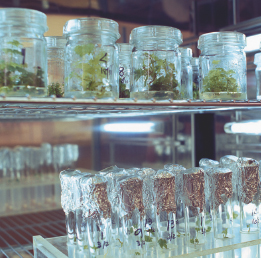
Meristem culture – the tissue culture of the 1mm tip of a vine shoot – allows the propagation of large numbers of plantlets hopefully free of virus.
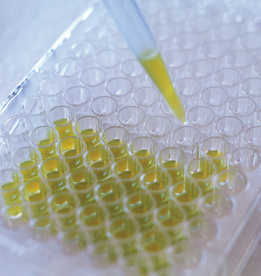
Elisa indexing is a serological test used to check vine pathogens and see if the virus elimination process was successful.
Some virus diseases may eventually kill the vine; others may make it chronically weak and underproducing. There is no easy way of curing virus diseases once a vineyard is infected: the viruses live on pieces of root in the soil and are spread by nematode worms. By growing cuttings at high temperatures (around 38°C/100°F) and then taking a cutting of just the very point of the growing tip it is possible, since the spread of viruses through the vine is always just a fraction behind the growth of the vine, to have a piece of vine that is free of viruses. From that you grow your new vine. (There is some debate about how much clonal variation is itself the result of varying viral incidence.)
Clones take a long time – often around 15 years – to be made commercially available to growers: the plants must be selected over several generations to ensure that they stay true to type. (Mutations may become more stable later on – or less stable.) Their resistance to disease and poor weather, and their suitability to different soil types must be tested; and, most importantly of all, the quality of their wine must be judged. Many clones produced in the 1970s produced high yields but poor quality wine; much current clonal research is aimed at putting right those mistakes.
GM vines: getting closer
In 2007 scientists at the Institut National de la Recherche Agronomique reported that they had cracked the genetic code of Vitis vinifera. Research into genetic modification of grapevines had already been started; field trials of GM vines have been underway in many places for some years now. But this unravelling of the whole genetic code opens the door to wider changes.
Do we want GM vines? What if it were possible to produce wine without chemical sprays, because they were immune to disease and rot? Resistance to mildew, both powdery and downy, is one of the first targets. Resistance to cold is another.
The French team has isolated large families of genes linked with the production of tannins and terpenes – the latter give flavours and aromas. What if they come up with grapes that produce the best-tasting wine the world has ever seen? Well, I’d certainly want to taste it. Wouldn’t you? What if you could raise the resveratrol content of red wine, thus perhaps increasing its anti-cancer properties? GM vines are not going to go away, and such pressing issues as climate change and the spread of so-far incurable vine infections are going to fuel the arguments. Sometimes it’s amazing how quickly one can change one’s mind.
Grapevines are not the same as maize or soya, and are of mercifully less interest to big agro-industrial companies. Once planted, vines generally remain in their vineyards for 30 years or more, unlike other crops which must be replanted from seed every year. With maize or soya there is the double profitability of every year selling seed genetically modified to resist a particular weedkiller, and then selling the weedkiller to go with it; that is not the case with vines.
But one big danger of GM vines is that of ever greater uniformity. The vineyards of the world are a huge resource of genetic variation: this new edition of Grapes & Vines includes numerous grapes that had been forgotten about, but which have come to prominence again as enterprising growers have rediscovered them. And that’s without considering the genetic variation in vines like Pinot Noir. If GM vines turn out to be as useful, as economical, as labour-saving as they could be, will growers continue to bother with these curiosities? Will massal selection become a thing of the past? And will we be confined to a diet of standardized flavours?
Genetically modified yeasts also exist, though they’re used mostly by the brewing and distilling industries so far. The aim of such yeasts is more efficient conversion of sugar to alcohol, and perhaps some built-in antimicrobial action. But what if GM yeasts could be used to reduce the alcohol level in wine? That’s becoming an obsession with a lot of winemakers now. So-called ‘lazy yeasts’ producing as much as one degree less of alcohol from a given level of sugar in the grape juice have already been isolated. If all the brainpower that has gone into making yeasts more efficient could be employed to make yeasts less efficient, and our wines far lower in alcohol but just as tasty – isn’t that extremely tempting, GM or not? These are issues we have to think about seriously – and not too emotionally.
Vine confusion: a question of identity
The identification of vines is a fascinating mixture of science and happenstance. Throughout human history people have traded and migrated; and they’ve taken their vines with them. With those vines have gone their local names; but new local names might later have been appended. So the same vine may be known by many different names in many different countries or regions. Conversely, the same name might be given to many different vines, even in the same region.
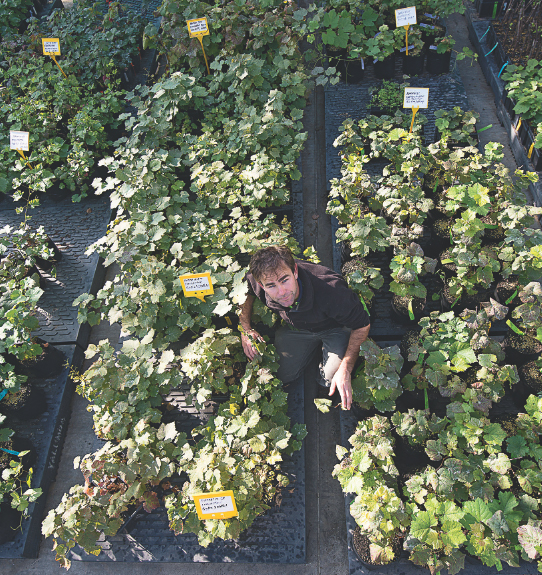
This is how infant vines are brought into the world at Yalumba’s nursery in Australia. Each is a cutting of a parent vine, and so genetically identical to its parent, and indeed to its siblings. Nevertheless, when sold to different growers and planted in different soils, climates and conditions, each will behave slightly differently. Planting laboratory-produced clones is a way of weeding out poor quality strains of a vine, but it need not produce identikit wines.
Chile has provided several of our most recent identity crises. Vines were brought out from Bordeaux in the 19th century and labelled haphazardly – one might suggest they were labelled according to what the market seemed to want. So Carmenère – a remarkable Bordeaux variety – was labelled by the easier to sell title of Merlot. Sauvignonasse – a rather neutral Bordeaux variety related to Sauvignon Blanc – was nonetheless called Sauvignon Blanc, because, well, which one would you buy? The search for the true Zinfandel has led us a merry dance through California, New York, Vienna, the heel of Italy and various tiny patches of vines in southern Croatia and produced a fistful of alternative names. Tribidrag seems to be the most ancient name for Zinfandel – so far. DNA studies have also revealed, for example, that Vermentino, Favorita and Pigato are all the same vine.
The results of DNA studies have been fascinating. Jancis Robinson, Julia Harding and José Vouillamoz (Wine Grapes, 2012) argue in favour of a small number of founder varieties responsible via natural crosses for the huge range of vines we have today: such founder varieties would include the ancestor(s) of Pinot and Savagnin, for example, which now head a pedigree involving no fewer than 165 varieties, including such well-known vines as Grüner Veltliner, Cabernet Sauvignon and Syrah, and such obscure ones as Raffiat de Moncade and Timpurie – neither of which could be squeezed into this book. Everything, it would seem, is interrelated.
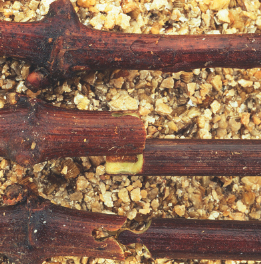
Omega grafting – named after the shape of the graft cut. The scion material is on the left, the rootstock on the right.
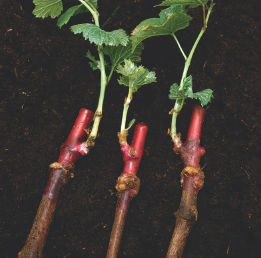
Newly grafted Pinot Noir vines. The red wax is for protection in the early weeks. The choice of rootstock is crucial to the quality of the future wine.
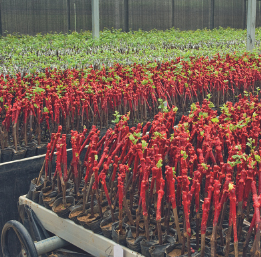
Thousands of waxed and grafted vinifera vines on American rootstock at Chateau Junding nursery in Shandong Province, China. Demand for healthy plant material is huge in China.
THE GLOBAL PICTURE
First of all, let’s get our bearings. This map shows where wine is grown: it gives the bare facts of latitude. It shows that most wine is grown between about 32˚ and 52˚ north, and about 26˚ and 45˚ south. If you’re thinking of making wine, that’s where you should stick your pin. After that, though, things get a little more complicated.
Northern hemisphere vineyards, as you can see from the figures above, tend to be at higher latitudes than those in the southern hemisphere. Partly this is for the very simple reason that most land masses in the southern hemisphere don’t extend all that far south: only the curving tail of South American goes past the 50˚ mark. That South Africa doesn’t extend any further south is certainly a great source of frustration to some of the producers there, who have difficulties in finding sites cool enough for some varieties – Pinot Noir, for example.
But the question of latitude is not just a simple one of temperature. The northern hemisphere is generally warmer than the southern at the same latitude, both in the growing season and over the course of the whole year. This is partly because of the greater land mass, and partly (as far as western Europe is concerned) because of the warming effect of the Gulf Stream. So comparing a northern latitude with a southern one can be misleading. Because it is possible (just) to ripen grapes successfully in southern England does not mean that the same grapes would ripen at the same latitude in Chile or Argentina. They wouldn’t.
The effect of latitude on wine flavour is enormous. Lower latitudes have early springs and late autumns, and thus provide the long ripening season that winemakers the world over covet: grapes that ripen slowly on the vine have time to develop plenty of flavour and aroma as well as just sugar. But on the other hand, low latitudes tend to mean high temperatures, so that grapes quickly reach high sugar levels, and lose acidity, which is the opposite of what growers want.
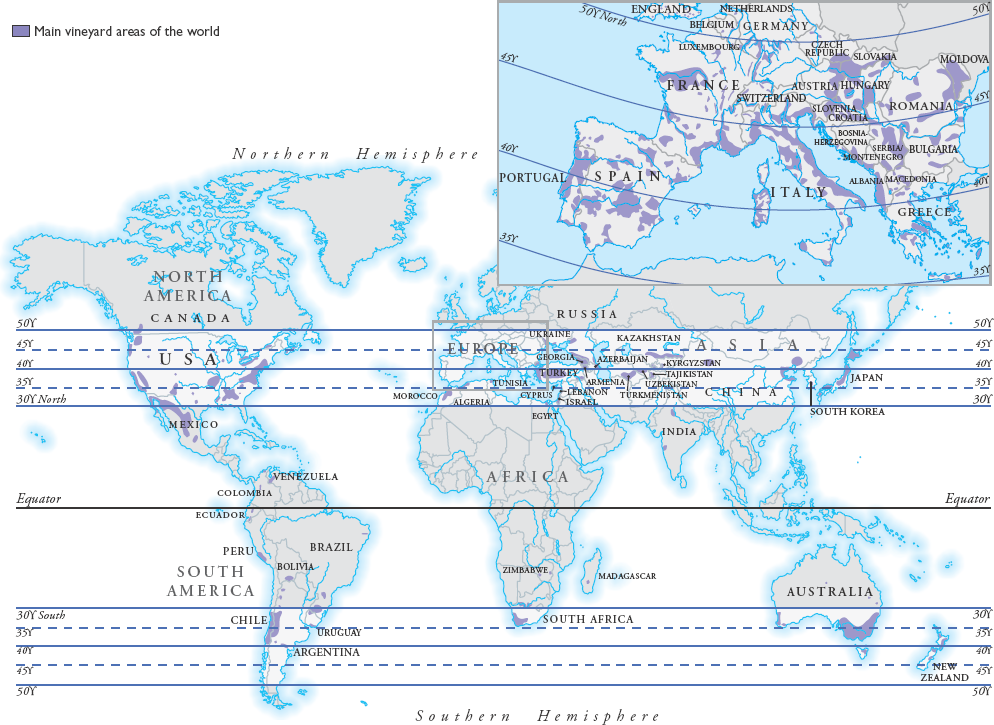
By contrast, higher latitudes mean shorter, cooler summers, but longer hours of daylight. More hours of daylight, and sunshine that is less fierce but lasts longer during the day, means more efficient photosynthesis, better retention of acidity and better development of flavour and aroma. Grapes ripen relatively faster at higher latitudes – in Bordeaux they reckon to have about 100 days between flowering and picking, whereas on California’s Central Coast the figure is more like 150 – but if the temperature is too cool there is nevertheless a risk that the grapes won’t ripen fully before autumn sets in.
Ideally, therefore, high latitudes need to be tempered with warm climates, and vice versa. We’ll be looking at climate more closely here onwards. The third element in the equation – and the element that balances the other two – is the grape variety.
What grows where
Contrary to expectations, the world total amount of land under vine has decreased since the 1950s. The 1951 figure of 8,845,130 hectares (ha) of vines peaked to 10,213,000ha in the late 1970s; then vine-pull schemes in Europe and the USSR started reducing the total. The aim in Europe was to drain the wine lake; the aim in the USSR was to reduce alcohol abuse. By 1998 both these initiatives were effectively over; the European one, at least, had succeeded in its aim. 1998 saw a world level of 7,716,000ha. Since 1998 there have been local adjustments and in 2012 (the most recent year for which figures exist), the world vineyard area totalled 7,528,000ha.
In the southern hemisphere, South Africa, New Zealand, Chile and Argentina have all shown significant percentage growths in the period since 2000 – New Zealand showed a staggering increase of 170% between 2000 and 2015. With an increasing emphasis on producing quality wines for the export market, this isn’t all made up of new plantings: many of these new vineyards are, in fact, replantings with better quality ‘international’ varieties.
In the same period China planted a further 270,000ha of vines, bringing its total to 570,000ha in 2012. Although the majority of these produce table grapes and raisins, plantings of wine grapes (mainly international grapes with some traditional Chinese, German and Russian varieties) are expanding rapidly. Despite the vine-pull schemes, Europe’s vineyards in 2011 still covered 4,253,000ha, which makes it far and away the world’s biggest grape-producing area. To put that in perspective, Australia had around 170,000, while in France, Languedoc-Roussillon alone had 193,748ha.
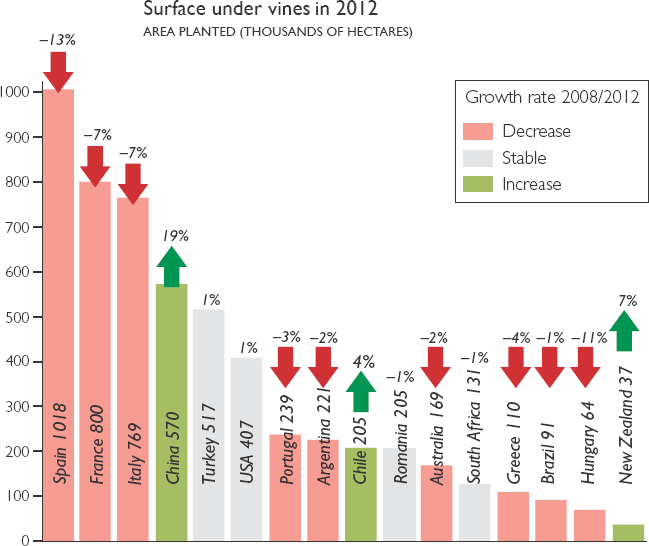
The starkest statistics here are those for the European powerhouses of Spain, France and Italy. Their longterm decline continues relentlessly and, pointedly, their wine consumption is slumping too. Hungary has also suffered a dramatic loss of vineyards, and only Romania, of the major producers, is reasonably steady. The figures for the USA and the Southern Hemisphere are more encouraging, and Australia’s slight decline is more a correction than a trend. Chile registers a 4% rise in vineyard area, but production has shot ahead by over 40%. New Zealand saw a 7% rise, but the rise since 2000 is 168%, and most suitable vineyard land is now planted. In China, accurate statistics are hard to come by, but there’s no doubt that the world’s biggest vineyard expansion is taking place in China – up 19% since 2008, and up 90% since 2000.
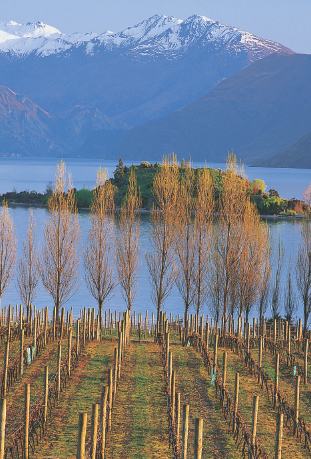
This is Lake Wanaka in Central Otago in New Zealand’s South island. Vineyard latitudes in the Southern Hemisphere don’t get much higher than Central Otago, at around 45° south, and according to climatic statistics it should be impossible to grow grapes here. In fact, though, the summer’s extremely long sunshine hours, and the almost complete lack of summer cloud cover combine with favourable local mesoclimates to produce conditions suitable for both Chardonnay and Pinot Noir.
WHERE GRAPES GROW
If climate and latitude alone determined where vines grew, life would be so much simpler. You would simply look at the sunshine, the temperature, the rainfall and the chance of frost, and work out what to plant where. Hey presto: great wine, every time. Unfortunately, it’s not quite that simple. Weather is only one of many factors that determine the quality and style of wine. When considering where grapes grow, it’s worth remembering that European vineyards were seldom planted after close analysis of the weather or the soil. If by chance they turned out to be great vineyards, then people tried to work out why. It’s been a long process of discovery, and it’s not over yet.

If it weren’t for the water, there wouldn’t be any wine here. The Finger Lakes in New York State have a relatively small surface area but are extremely deep and seldom freeze in winter, so act as a very efficient heat store. Vineyards on the surrounding hillsides are protected against extreme winter temperatures and late spring frosts, and enjoy milder autumns than areas further away.
Winemakers have been studying Burgundy’s Côte d’Or for years, but we still don’t know precisely what it is about this little stretch of French vineyard that produces such marvellous Pinot Noir and Chardonnay. And if people can’t agree on that, it’s not surprising that they also can’t agree on which of the attributes of the Côte d’Or you should try to imitate if you want to make great Pinot elsewhere, or how closely you should imitate them. Should you find somewhere that mimics the Burgundian climate? Or is the climate in fact a disadvantage? If you think that, then you’ll seek somewhere warmer and drier. Should you be trying to copy the soil? And if so, should you be looking at its structure, its mineral content, or what?
Vineyard dirt is receiving intense study from winemakers everywhere. Even those few who seem perversely determined to eradicate all traces of terroir in their wines by overripeness, massive extraction and as much manipulation as possible in the winery (added tannins, added acidity, added colour) still take pride in having good or even great terroir. Terroir has swung back into fashion, big time. In Bordeaux, top châteaux divide their parcels of vines ever more precisely according to which bits ripen together – a parcel might be one hectare, or half a row; there’s really no limit to how precise you can be – and then redesign their wineries to suit, with one vat, appropriately sized, for each parcel. Suddenly they’re able to ferment individual parcels that have never before been fermented separately, and the effect on the wine, in terms of precision and accuracy, can be dramatic. Accuracy in the wine comes from accuracy in the winery, which comes directly from accuracy in the vineyard – via, it has to be said, a substantial investment budget.
Yet as we’re seeing in Champagne, while it wrestles with the complexities of bringing into the appellation those bits of land judged to be at least as good as those already in it, analyzing terroir is one thing. Proving that one terroir is better or worse than another is quite another, though it provides a gratifying amount of work for m’learned friends, since these matters always seem to end up in court.
Terroir
This is still a relatively poorly understood concept – but it is important to realize that ‘terroir’ does not mean ‘soil’. The terroir of a vineyard is the sum of all its parts: its geology, its climate, its topology, its water-holding ability and the amount of sun it receives, and the effect of man. Without human intervention there wouldn’t be vineyards in the first place. So the soil, both topsoil and subsoil, is important, as are the mineral components of the soil. How fertile or infertile it is, and its depth and structure, which affects how well or poorly drained it is, are also factors. Altitude, steepness of slope and exposure to the sun all matter, as does the mesoclimate, or climate particular to that vineyard. From the French point of view (and it is most of all a French concept), it is the terroir that makes each vineyard different. It underpins the Appellation Contrôlée system not least because, as the underlying factor behind wine quality and style, it should show in the wine no matter who the winemaker is or what he or she does to the wine. Winemakers come and go; the terroir remains.
However, good viticulture and winemaking can permit the expression of the terroir while bad viticulture and winemaking can mask it. And since good vineyard practice can mean installing drainage where necessary, thereby changing the soil’s character, and since good winemaking in northern Europe does not exclude chaptalization (the addition of sugar before or during fermentation to increase a wine’s alcoholic strength; see here), growers are in practice not absolute slaves to what their terroir dictates.
Climate
It’s not surprising that so many winegrowers pay more attention to climate than to any other factor: its effects are obvious and undeniable. Even the most dedicated terroiriste is likely to blame the weather rather than the terroir when his vines are hit by spring frost (although those with vineyards sited outside frost pockets may well smugly praise their terroir when they escape). Rain or high winds during flowering; drought in late summer, causing photosynthesis, and thus the ripening process, to stop; summer rain that provides the humidity in which rot can attack the grapes; rain at harvest which dilutes the juice; hail at any time: the climatic hazards faced by the grower are endless. In Europe, growers are largely stuck with existing appellation boundaries and the weather conditions that go with them. In the New World you can plant a vineyard where you like – which in practice means, since the perfect vineyard site does not exist, that up to a point you choose your problems rather than inherit them.
Nevertheless, the weather during the growing season does not make much difference to the quality of the vintage until véraison (the onset of ripening, when the hard, green immature fruit softens and takes on the colour of the ripe grape) takes place. Spring frosts or excessive water stress (i.e. drought) may reduce quantity, but as far as quality is concerned it is the last couple of months before the harvest that really matter.
Cool or warm
There is no absolute definition of what constitutes a cool, warm or hot climate for viticulture: what feels cool to a grower in California’s Napa Valley might seem warm to a grower in the Saar Valley of Germany. A cool climate is usually understood to mean one where only early-ripening grape varieties will ripen: grapes like Pinot Noir, Riesling, Chardonnay or Gewürztraminer. An intermediate climate will ripen later-ripening varieties like Merlot, Cabernet Sauvignon and Syrah. In warm climates you get very late-ripening grapes like Mourvèdre, Grenache and Touriga Nacional, but also earlier-ripening varieties such as Muscat if the aim is sweet fortified wines. Carneros and Sonoma Coast in California, Oregon, Australia’s Mornington Peninsula, New Zealand’s South Island, Burgundy, Germany and, obviously, England come under the heading of cool climate; Bordeaux, Tuscany, California’s Napa Valley, Spain’s Rioja, Chile’s Maipo and Australia’s Coonawarra and Margaret River are intermediate. The south of France, the Douro Valley in Portugal, Jerez in Spain, most of Mendoza in Argentina and McLaren Vale in Australia are warm.
Hot climates grow grapes mostly for raisins or table grapes, though wine is made nevertheless in some tropical climates in South America and elsewhere.
THE WINKLER AND AMERINE HEAT SUMMATION SCALE
It is only right to give a proper account of the Winkler and Amerine Degree Day System, since it governed so much of what was planted and where in California from the 1940s on up until relatively recently.
Albert Julius Winkler (1894–1989) was a scientist at the University of California at Davis (UCD), the leading US viticultural research institute as well as the leading US college for aspiring winegrowers and makers. He and Maynard Amerine (1911–98), also of UCD, devised a system of classifying the regions of California by heat summations. They assumed a growing season that extended from 1 April to 31 October, and worked out the number of ‘degree days’ in different regions. This was done by calculating the amount by which the temperature exceeded 50°F/10°C, which is the lowest temperature at which the vine will grow. They divided California into five different regions, with Region I, the coolest, having fewer than 2500 degree days, to Region V, with more than 4000. Specific grape varieties were then recommended for each region.
When applied to California the system is broadly reliable, since it so happens that in California temperature is a pretty good guide to overall climate. Elsewhere it works less well: applied to Australia, for example, it would deny the possibility of making good Semillon in New South Wales’s Hunter Valley – yet Hunter Semillon is one of the classic wine styles of Australia.
Mediterranean or Continental
A Mediterranean climate has the sort of mild winters and long, warm summers that prevail around the Mediterranean. A Continental climate is more extreme, with colder winters and hotter, sometimes shorter, summers. More inland parts of Europe, such as Germany, Austria and Hungary, have a Continental climate. Regions near the sea, like Bordeaux, have a maritime climate: the proximity of a large body of water tempers extremes of heat and cold, but also brings the danger of storms and rain.
Having an expanse of water near a vineyard can, in fact, be vital in marginal climates (a marginal climate is one where a given grape variety will only just ripen: marginal climates often produce the most complex, elegant wines – in years when there’s enough sun, that is. The downside of the equation is raw, green wine when the sun doesn’t shine). A large river or lake, by acting as a heat store, can raise the average temperature by a vital degree or two. It’s one of the reasons why Riesling will ripen on the southeast- to southwest-facing banks of the Mosel, but not further away from the river’s edge.
Getting warmer?
It’s a question that preoccupies many growers: how to deal with climate change? In Australia, for example, they’re increasingly looking at vines that can survive heat and need little irrigation. Champagne growers have been seen prowling round the chalk slopes of southern England. And China, where there is great scope for planting further north, and further north again, could be a net beneficiary.
There’s no question that the climate is changing, says Giuseppe Rizzardi of Guerrieri-Rizzardi, producer of Bardolino and Valpolicella: ‘the grapes tell us so’. Grapes are the ultimate, unarguable voice of climate change. They don’t tell you what’s causing it; all they tell you is whether they like it or not.
Interestingly, grapes in many European regions do like it, so far. German Riesling has moved into its comfort zone: until the 1980s catastrophic vintages were not uncommon, and it was legal for growers to add water to their wines to reduce the acidity. Bordeaux and Burgundy have more good vintages than poor ones now. Champagne is on a roll, and vintage wines are now made almost every year, though not always by the same houses.
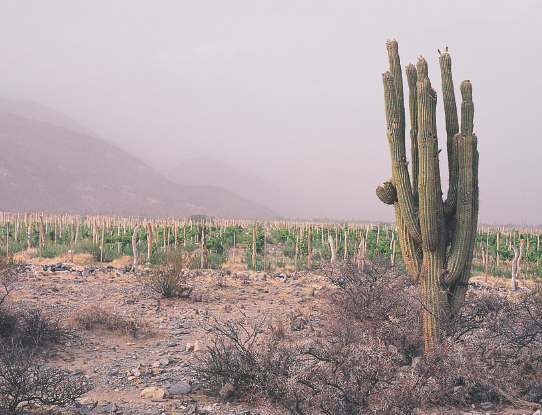
In a very hot country you may have to go very, very high up to find a suitable climate for growing vines. In Catamarca in Argentina, Michel Torino has planted vines at around 2400m (7880ft): luckily the Andes happen to be there to provide such sites.
What we don’t yet necessarily know is how great each vine’s comfort zone – its plasticity, or its ability to adapt – is. Chardonnay is pretty flexible: it can grow almost anywhere. For Riesling, we will eventually find out.
Defining ripeness
What exactly is ripeness? On the face of it, it seems a silly question. We all know the difference between a ripe plum and an unripe one. But take the analogy of bananas. Some people consider a banana to be ripe when the skin is yellow all over. To others, a ripe banana has a skin speckled with black. In wine, a grape that is considered ripe in Champagne would be thought unripe in the Napa Valley. The high acid/low sugar ‘ripeness’ that is crucial for making sparkling wines of balance and vivacity in Champagne makes painfully acidic table wines. Napa’s sun-soaked grapes make full-bodied table wines but would make fat, flabby fizz.
High sugar levels do not, on their own, constitute ripeness. A ripe grape has brown seeds, not green, and the stalk is lignified to the first joint of the bunch. When you taste it (and all good wine producers judge ripeness by taste first, and by analysis second), a red grape should have minimal vegetal green bean flavour, and its skin tannins should be soft and velvety. In other words, the aim is physiological ripeness, and in warmer climates this occurs at higher sugar levels than in cooler climates, simply because it cannot be hurried. Heat will speed up sugar formation; but for tannin ripeness you simply have to wait. This is why ripe grapes in Australia’s Barossa will tend to produce more alcoholic wines than grapes of similar physiological ripeness in Bordeaux. The battle in warm regions is to attain full physiological ripeness without head-banging levels of alcohol: get the equation wrong and you end up with over 15 per cent alcohol and you still get unripe flavours.
The ideal is to have sugar ripeness and tannin ripeness at the same time. We would argue that this is one of the criteria of a great terroir. We would even question whether places that find this impossible, at least in the majority of years, can be considered great terroirs. To have sugar ripeness hugely out of sync with tannin ripeness makes it impossible to have balanced wines without regular intervention in the winery, whether it’s to add acidity or to add sugar. Is this too demanding an approach? Since it would rule out most of Western Europe at least until the 1980s, and much of the New World now, it perhaps is. But if were are talking about a great terroir – no, it’s not too demanding. And whereas until the 1980s the wine world’s problems were mostly about trying to make up for lack of ripeness, climate change means that an increasing number of our problems nowadays are to do with overripeness and loss of any ‘typical’ flavours from a vineyard. Grapes will have to be grown differently, and, if necessary, different varieties will need to be planted, ones which can express their sense of place in our warmer world. However you look at it, climate is an integral part of terroir.
Picking grapes too early can be unavoidable, if rain is on the way, or if, in cooler areas, a bad summer or autumn has meant that the grapes can’t ripen. In white grapes this means high levels of sharp-tasting malic acid; leaving the grapes on the vine for longer would mean lower levels of malic acid, which falls as the grapes ripen, and higher levels of the riper-tasting tartaric acid.
In red grapes, there is the additional factor of tannins, which should be silky. Green tannins range from dry to bitter and unpleasant, but a touch of greenness in flavour can add some balancing freshness without being in the least frightening; most great Bordeaux of the 20th century had a streak of greenness in them. Some producers, however, particularly in California’s Napa Valley, but also in various other New World areas as well as parts of Spain and Italy and even in patches of Bordeaux itself, dread the thought of green tannins so much that they are apt to leave the grapes on the vine until they are shrivelled and are heading for raisin status. By this time sugar levels are sky-high and acidity is falling faster than stock markets after a Euro crisis. The wines may have tannins so soft you could wrap a baby in them, or they may have just got fiercer and fiercer, but either way, the wines have lost most of the freshness that makes you want to drink them. And as for the alcohol, well, either it’s very high, or has been reduced from ‘very high’ by perfectly legal but hardly desirable methods involving dilution or manipulation of the grape juice or wine. It is perfectly possible to produce ripe, silky tannins without destroying the wine’s freshness, but you need the magic combination of a good ripening season in a relatively cool climate that will hold the sugar level back and prevent the grapes shrivelling to raisins while you wait for the tannins to ripen. Bordeaux at its finest is the best example of this.
How much alcohol?
If you can taste the alcohol on the palate, as a burn on the finish or, even worse, all the way through the wine, the wine is not in balance. It may be a good wine in all other respects, but alcohol that sticks out is a fault. Balance can be found in wines of 14.5 or 15 per cent; unbalanced wines can be found at 13.5 per cent. Alcohol levels are not a problem in themselves; it is lack of balance that is the problem. But it has to be said that high alcohol tends to go hand in hand with lack of aroma, lack of freshness and general soupiness because the more you search for higher sugars, the more acidity the grape will lose. Good acidity balances high alcohol and inadequate acidity will taste jammy, soupy and tiring.
There are many reasons for the apparently inexorable rise of alcohol in recent years. Warmer summers mean more sugar in the grapes; the desire for riper tannins means longer hang times; vigorous, virus-free clones also put in their ha’porth and the pruning of the vine to produce self-defeatingly small crops of grapes per plant whacks up the sugar. Ways of bringing alcohol down, or at least getting it under control, include long-term strategies like planting at higher altitudes and higher latitudes, and shorter-term ones like the development of less efficient yeasts; de-alcoholization of wine, where it is allowed; adding water to the must, where that is allowed(!); open-topped fermenters that allow some alcohol to evaporate during fermentation; less leaf-pulling and more shading of clusters; and greater selection in vineyard and winery.
Château Margaux brought the alcohol in its white wine, Pavillon Blanc, down from more than 15 per cent in 2007 to 13.4 per cent in 2012 by, among other measures, using only the first part of the juice to be pressed off the skins, which has less sugar and more acidity, and rejecting the later part, which is closer to the skins, lower in acidity and higher in sugar. In the case of Pavillon Blanc, these measures may mean rejecting 60 per cent of the crop. As with restructuring your winery to suit your vineyard and thus reflect your terroir, it helps not to be skint.
COMMON VINEYARD SOILS
What you see at the surface of the vineyard may be material deposited by rivers, glaciers or erosion, or it may be the topsoil: the weathered bedrock combined with organic matter. If this layer is too fertile the vine will spread its roots sideways, rather than sending them deep – sometimes as much as 30m (100ft) – into the subsoil to establish a stable foundation. The subsoil, or pure weathered bedrock, may be relatively uniform or may consist of several strata.
Alluvial: soil deposited by rivers. Alluvial soils can be very fertile, and contain sand, silt and gravel. Argillaceous: includes clays, marls, shales and others. Calcareous: contains calcium and magnesium carbonates. These are cool, water-retaining soils; usually alkaline, they give grapes with high acidity. Chalk: a type of limestone. It is cool and alkaline, and combines good drainage with sufficient moisture retention. Clay: cold, acid, poorly drained soil. Solid clay is difficult for vines, but clay mixed with other soils, in particular calcareous soils, can be excellent for vine growing. Clayey-loam: even more fertile than loam on its own. Can drain poorly in wet weather. Ferruginous clay: clay with an admixture of iron. Gneiss: a type of granite. Granite: warm, mineral-rich soil that tends to produce grapes low in acidity. Gravel: pebbly, well-drained soil, generally infertile. It is acid, so produces grapes with low acidity. Gravel over the alkaline limestone gives wines with more acidity than gravel over clay. Limestone: carbonate-rich alkaline soil. There are various sorts of limestone, of which chalk is one. Different limestones have different water retention. Limestone soils generally give grapes with high acidity. The Kimmeridgian soil of Chablis is a calcareous clay containing Kimmeridgian limestone. Loam: warm, fertile soil – generally too fertile, in fact, for fine wine. Loam contains clay, silt and sand. Marl: calcareous clay. Marl is cold soil that holds back ripening and gives wines with high acidity. Sand: fine-grained, warm soil that drains freely. Sandstone: rock with sand-sized particles bound together by minerals or forced together by pressure. Sandy-loam: loam with a large admixture of sand. Sandy loam is warm and well drained. Schist: warm, splintery, crystalline rock derived from shale, sandstone or granite. Shale: warm, reasonably fertile soil. Slate: warm, well-drained soil. Slate soils like those in the Mosel can consist almost entirely of thinly split fragments of rock.

Large stones like these at Ata Rangi in Martinborough, New Zealand, can act as a heat store, soaking up heat during the day to advance ripening in what is a cool, marginal climate.
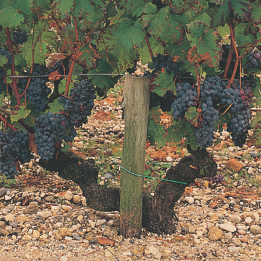
The deep beds of gravel here in Pessac-Léognan are warm and provide good drainage, which is vital in Bordeaux’s damp climate, and can make all the difference between good and mediocre wine.
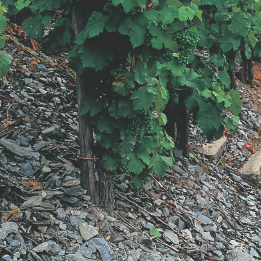
Again, good drainage and warmth are the key advantages of the slate of Germany’s Middle Mosel region. There is so little actual soil here that one wonders how vines live at all.

The Elqui Valley in Chile should really be too warm for growing good grapes, bordering on the Atacama Desert at 29˚ South. But a mixture of high altitudes – grapes are grown at up to 2000m (6600ft) altitude – and keen icy winds drawn up the valley from a Pacific shore cooled down by the Antarctic Humboldt Current has seen exciting wines produced, particularly from the Syrah grape. Indeed, these steep granite slopes bear some resemblance to Syrah’s homeland – the Northern Rhône Valley in France.
The rise of balance
This is the cause of much cheering in the wine world. Excess alcohol looks dated, and – hooray! – so does excess oak. Regions that had previously made wines in which you could stand a spoon up are now making wines that offer a sense of place instead of a sense of prunes in brandy. Priorat is fresher, more appetizing and far less intimidating than it was, without being a jot less impressive. Barossa is becoming far too aware of its varied terroir to want to cover it up. Australian Chardonnay is now crisp and elegant and the delights of cool climate Syrah (not Shiraz) are increasingly being lauded. Chile is now looking to newer, cooler regions like Elqui and Limarí for its stylistic guides, and even Central Valley wines are looking lighter. Producers in Argentina are pushing higher and higher up in the Andes. Winemakers, having discovered how to do ripeness, are now having fun doing restraint.
Fashion is moving away from both overripeness and overextraction, but it’s important to differentiate between them. We’ve discussed the former; the latter happens in the winery. You can have overextraction without overripeness, and hard, dry tannins are the result. You can have overripeness without overextraction: you get a soft jamminess. But because alcohol is such a good extractor of tannins, the first usually leads to the second.
Climate and photosynthesis
Vines produce sugar by photosynthesis, the process in which sunlight is used to combine water with atmospheric carbon dioxide. The sugar thus made in the leaves is transported to the grapes. At low temperatures photosynthesis, and thus the ripening process, stops. But it also stops at high temperatures, and in drought conditions. In very hot, dry spells, if no irrigation is available, grapes may shrivel, but they won’t ripen. This is why it’s perfectly possible to get overripe, jammy flavours hand in hand with green tannins.
The heights and the slopes
One of the few incontrovertible statements one can make about vineyards is that higher altitudes are cooler. In California they reckon that the temperature cools by 2.2°C (3.96°F) for every 329m (1080ft) of altitude. This may not be a conveniently round figure, but it shows that if you want the longer summer that goes with lower latitude, you can get a cooler climate – and thus get the possibility of very long hang time, with all the benefits to ripeness and flavour that that implies – by heading up into the mountains. It’s worth remembering that 19th-century vineyard pioneers in California chose the hillsides, not the valley floors.
Go too high, of course, and you may find that your grapes won’t ripen properly. On the Côte d’Or and in Hungary’s Tokaj region it is the middle of the slopes that produce the best, ripest grapes. In Portugal’s Douro Valley the highest vineyards may ripen two to three weeks after those nearer the river, and may indeed be too cool for port; but they come into their own for unfortified table wine, which needs less sugar but more acidity.
But slopes have another advantage, too: they get more direct sunshine – crucially when the sun rises lower in the sky as late summer heads in to autumn/fall. In cool climates that means better ripeness. They also tend to have poorer, thinner, better drained, less fertile soil, which acts as a natural brake on the vigour of the vine; this in turn helps to control the amount of grapes the vine produces, and gives more concentrated flavours.
Planting on valley floors is certainly desirable if you want to produce large quantities of inexpensive wine. But this is not to suggest that only sloping vineyards are good. In areas that seem flat, minor gradations of only a few metres can dramatically change the quality of the soil. This is particularly true in gravelly regions, where ridges of gravel give well-drained infertile soil conditions, yet the troughs between the ridges are fuller of more fertile, damper clay soils, likely to give bigger crops of slower-ripening fruit. And in some of these seemingly flat areas, the changes can happen several times across 100m (330ft). In marginal and cool climate regions, this has a dramatic effect on the final flavour of the wine. The gravelly Médoc looks remarkably flat to the untutored eye, and the stony vineyards of Marlborough in New Zealand, seem to be about as flat as land can be, but are in fact full of gentle rises and falls, with gravel on the ridges and clays in the troughs. The floor of the Napa Valley seems to be ultra-flat, but underneath the surface all kinds of intricate geological patterns are woven.
Back to the soil
One of the current buzzwords in wine is ‘minerality’. Ask 10 people to define it and you’ll get 10 different definitions; ours would be that minerality is a certain saltiness, savouriness or stoniness – sometimes even a metallic quality – on the palate that is not fruitiness and not precisely earthiness, either.
Where does it come from, and how does it get into the wine? Is it a function of ripeness or lack of ripeness? Is it low-level reduction, or is it a genuine soil flavour?
Let’s dispose of the second suggestions first. There seems to be a correlation between certain soil and certain characteristics in wine: the slate of the Mosel is instantly recognizable as a smoky tang in the valley’s Riesling; limestone gives liveliness, clay gives weight and solidity; and volcanic soil gives a certain fieriness, a sparkiness, which sounds like a bad case of auto-suggestion, but which is recognizable. But these notes do not result from some movement of slate or clay or volcanic molecules through the vine, into the grapes and, through fermentation, into the wine. Or, at least, no pathway for such movement has yet been identified by plant biologists. Until such a pathway is discovered we should assume that while Chablis might have a trademark flavour that is like licking limestone, what we are tasting is not actually limestone – not yet, anyway.
Some authorities suggest that what we term minerality may derive from esters, which are created when alcohol reacts with organic acids, and which vaporize easily. In addition, the gunflint note associated with some Sauvignon Blanc comes from a volatile thiol, Benzenemethanethiol (BMT); volatile thiols are associated with low levels of reduction or sulphides, and it is possible that sometimes ‘minerality’ of this ‘gunflint’ variety may be the result of bottling under screwcap.
Growers who have minerality in their wines, along with those who covet it, maintain that it comes from old, deep-rooted vines with the ability to extract nutrients from way down in the soil, aided by the presence of mycorrhizal fungi in the soil. It’s true that minerality has been more associated with the Old World than the New, where irrigation tends to make life in the top 50cm (20in) of soil much more enticing for a vine; at the same time the popularity of screwcaps does seem to have made minerality much more discernible in New Zealand Sauvignon Blanc. In addition, some vintages in Chablis show more minerality than others and a cooler Mosel vintage may seem more slatey than a warmer one, suggesting that ripeness levels can be a factor, with less ripe vintages displaying more minerality.

Chardonnay vines growing on the pale chalky slopes of Le Mesnil-sur-Oger, a Grand Cru village famous for its Chardonnay. The belemnite chalk spreads right down the Côte des Blancs; its whiteness reflects sunlight back on the vines, yet it retains some heat and just enough moisture, and its alkalinity is crucial in creating the acidity in the Chardonnay juice so prized by winemakers.
More research is needed. And when we know what it is, it should be a lot easier to agree on a definition of what it tastes like. But, I don’t know, I think it’ll remain subjective for a fair while yet.
The physical structure of soil should, however, be differentiated from its chemical attributes. Most authorities agree that the most important aspect of soil is its water-holding capacity, and how easily the vine can access that water. What vines like best is well-drained soils that nevertheless have an adequate, but not too high, supply of water. The chalk of Champagne and southern England is an example: chalk drains freely yet maintains a high water table, and the water is accessible to the vine. Clay, by contrast, drains poorly, yet can be so dense that much of its water content may be inaccessible to the vine’s roots. Wet soils are cold soils; well-drained soils are warmer. Well-drained soils are thus likely to encourage budbreak earlier in the season, and aid ripening; they can be suitable for later-ripening varieties in marginal climates because they speed them up. A cold soil might be better suited to an earlier ripening variety. In Bordeaux, for example, Merlot does better on the clay soils of Pomerol and St-Émilion, where the later-ripening Cabernet Sauvignon would not ripen. Cabernet needs the warmer, freely draining gravel soil of the Médoc, where Merlot might overripen in hot years. Dark soils are warmer; light-coloured soils are colder. And very stony soils, such as those found in parts of Châteauneuf-du-Pape, conduct and hold the heat well, again aiding ripening of the grapes.
Some aspects of the chemical and mineral content of soil are more clearly understood and can be related to other crops. There is certainly a direct relationship between excess nitrogen and excess growth: vines getting too much nitrogen produce enormous quantities of leaves that in turn shade the grapes and hinder ripening. Too much potassium in the soil can reduce the acidity of wine. (Potassium-based fertilizers, very popular in the 1970s, are out of fashion.) High levels of organic matter mean very fertile soils, and these, too, can mean problems of excess vigour in the vine leading to yield and ripening challenges. But the vine must have some organic matter in the soil. Very poor, infertile soils can indeed encourage the vine to put down very deep roots in search of nutrients, but if it doesn’t find those nutrients anywhere it won’t flourish.
IN THE VINEYARD
Great wine is made in the vineyard. That is an article of faith, and is quoted even by winemakers who, judging by the results, must do a great deal of their making in the cellar. It’s not that winemakers are becoming, on the whole, less technical: every year there’s a new bit of kit that is a must-have for anyone with the budget. Many of these new acquisitions, however, are aimed at enabling winemakers to identify the very best grapes as the crop arrives at the winery, and then to ease their transformation into wine with the least possible trauma. Technically this allows you to have grapes as perfect as possible. But might you not be losing a bit of personality along the way? And what does perfect mean?
Manual sorting tables in the winery were upstaged by optical sorting tables; now, if you pick by machine, you can sort ripe grapes from unripe by using the Tribaie system, which was invented by Bordeaux grower Philippe Bardet. First a vibrating belt excludes small, green berries. Then the berries pass into a rotating drum. Damaged berries stick to the walls, while sound ones fall into a container of fresh grape must. Ripe grapes sink, unripe grapes float: it’s the same principle as ducking for witches, really.
But we’re jumping the gun. We’re supposed to be talking about vineyards, not wineries; and it’s been interesting to see the way that biodynamism (see here for a full description) has moved closer and closer to the mainstream. In Bordeaux, Châteaux Latour and Margaux, among many others, have a hectare or two under biodynamic trial; Château Palmer makes its own compost from its vine prunings; Château Climens in Sauternes and Château Pontet-Canet in the Médoc are fully biodynamic, and the latter is moving from tractors to horses for vineyard work. These châteaux are not run by wannabe hippies. They are run by businesspeople and scientists who want to make better and better wine. If it works, they’ll do it, and only afterwards try and work out why it works. What we have now is a spectrum of practices with industrial winemaking at one end, spraying fertilizers, herbicides and anti-rot sprays with a merry heart, supplying the brands that want total reliability and consistency. Then there is lutte raisonnée, which generally means using as few chemicals as possible but as many as necessary; then there is organic viticulture, the definition of which varies according to which organic certification organization you choose to belong; then there is biodynamism; then there are natural wines.

Plastic grow tubes in a new plantation of vines in Walla Walla, Washington State, USA. The tubes resemble a mini greenhouse speeding up growth. The first crop of grapes can be as much as a year earlier when tubes are used. And if there are any little critters in the vineyard who’d like to chew on the shoots, they can’t get at them.
Natural wines are also undefined, though biodynamism is usually a given. But they also embrace wines made in clay amphorae, white wines macerated on the skins, known as ‘orange wines’ (these may well be amphora vines) and zero or minimal sulphur wines. It’s a holistic approach that brings cellar and vineyard into the same embrace; and while many drinkers may find intentionally oxidized wines and bottle variation an embrace too far, the effect of natural wines is being felt throughout the mainstream – whatever that is. So we feel justified in beginning this chapter with a tangential discussion about cellar practices: cellar and vineyard are starting to merge into a continuum. Which, one could argue, is what they always used to be, before chemicals effected a revolution in the vineyards, and technology a revolution in the cellar. The problems that made chemicals sprays so popular in the first place do not, however, go away.
Phylloxera: the coming of the plague
Phylloxera still necessitates grafting every vine in most parts of the world. It is the only protection there is against Phylloxera vastatrix, the tiny aphid that at one stage of its complicated life cycle feeds on vine roots and kills the vine. Phylloxera invaded from the east coast of the United States in the second half of the 19th century, and vines throughout Europe were wiped out. It found its way to Australia in 1877 (though parts of Australia are still phylloxera-free), California in 1873 and New Zealand and South Africa by 1885.
The emergence of Biotype B in California attacked vines which had been grafted on to AXR1 rootstocks that were only semi-resistant to phylloxera, and widespread replanting took place in the 1990s.

A familiar sight in 1990s California wine country: burning phylloxera-affected vines that had been planted on insufficiently resistant rootstocks. This bonfire is in St Helena, Napa Valley.
A question of graft
The vines used for phylloxera-resistant rootstocks are bred from native American species like Vitis riparia, which have natural immunity. There are dozens of different rootstocks now in common use, but it takes some years to determine by means of field trials just which rootstocks are most suitable in which circumstances and on which site. Some, like 333 EM and 41 B, are particularly tolerant to lime in soil, and are thus suitable for chalky soils like those found in Champagne. Others, like 110 R, are tolerant of drought; SO 4, Ramsey, Dog Ridge, 1613 C and others are resistant to nematodes, but SO 4 gives high yields and roots only shallowly; Rupestris St George, 99 R and 110 R are very vigorous, and produce huge canopies in their scions, which can be a problem; 101-14 and Riparia Gloire, by contrast, have very low vigour and so can be used to curb the vigour of vines in very fertile soils. Ramsey is good at seeking out water, and is resistant to salinity, which can make it useful in Australia. 101-14 is useful for deficit irrigation.
Nematodes are tiny worm-like organisms that live in the soil and spread viruses – and they in themselves can be a good enough reason for grafting vines on to resistant rootstock, even if there’s no phylloxera problem in your region. Even in relatively disease-free Chile, where nematodes are not generally a big problem, they can flourish in the sandy parts of Casablanca, and nematode-resistant rootstocks are being found to be necessary if vines are to flourish there.
It was only really in the latter part of the 20th century that producers began to realize the importance of having the correct rootstock. At Château Angélus in St-Émilion, for example, the current generation say that when they took over in the 1980s, only about 30 per cent of the vines were on the right rootstocks. The choice of rootstock can affect the berry size, the leaf area and the leaf-to-berry ratio, all of which have quality implications for the wine.
To clone or not to clone
While clones of some varieties like Pinot Noir, as we’ve seen here, can vary widely in quality, in vine varieties where there is less variation the choice of clone probably only accounts for between 1 and 5 per cent of the quality of the wine. So your choice of clone if you are growing Riesling is less important than if you are growing the genetically more variable Pinot Noir. And in both cases good viticulture is more important. To make a decision not to plant clones is almost impossible in many parts of the world: if your entire region was planted with scratch from clones, as is the case in much of the New World, then clones are what you have. Even in Austria, Toni Bodenstein of Prager has to label his massal selection vineyards as ‘experimental’ in order to make them legal; and he spent three years searching for good Riesling and Grüner Veltliner vines from which to take cuttings, eventually settling on 25 Riesling selections and 110 Grüner Veltliners. He prefers them because their yields are naturally lower and he has to spend less time green-harvesting; ‘it enables you to work better with nature,’ he says.
OLD VINES
In the case of vines, age and beauty generally (though not always) go hand in hand. European vines are not permitted to produce appellation contrôlée (or the equivalent) wine until their fourth year, but that is still infancy in vine terms. After about 20 years vines become less vigorous and produce smaller crops of more concentrated fruit, and at a certain age – usually about 30 years – the producer has to decide if he values the increased quality more than the drop in yield. Most vines are uprooted at this point, and replaced.
Wine from old vines thus has some extra cachet. The only problem is defining how old is old. Some wines which blazon the words ‘old vines’ or ‘vieilles vignes’ on the label may be made from vines of only about 35 years, which is not even middle-aged, far less old.
So where can you find really old vines? Australia has plenty of Shiraz and Grenache, especially in the Barossa, which was planted more than a century ago: Turkey Flat can boast some of 170 years old. Chile has many vines of 70 years or more, and California has old Zinfandel and Carignane vines that are more than 100 years old. Madera County in particular has large plantings of old Carignane left over from a previous fashion that nobody ever bothered to uproot.
In Piedmont, Italy, Marcarini has some centenarian Dolcetto on its own roots in the cru of La Morra, and in Campania there is some Syrah and Aglianico, around the same age, which have grown to the size of small apple trees. In Germany’s Mosel Valley, Ernst Loosen has some Riesling vines of 100 years old in the Ürziger Würzgarten vineyard.
Old vines certainly produce wine of greater intensity, but don’t forget that many of the great 1961 Pomerols and St-Émilions came from vines that had been replanted after the devastating winter of 1956.
Pre-phylloxera vines
Technically these are vines that date from before phylloxera took hold at the end of the 19th century – which would make them very old indeed. But the phrase is sometimes used to refer to ungrafted vines – and these are less rare than one might suppose. In Europe some of the most famous are at Quinta do Noval in the Douro Valley in Portugal, which produces its rare Nacional port from half-a-dozen small terraces of ungrafted vines. The vines all around are grafted, and attempts to extend ungrafted vines to other parts of the vineyard have always failed. For some reason, phylloxera never affected those particular parts of the vineyard – nobody knows why.
Elsewhere in Europe the Middle Mosel is still free of phylloxera and there are many vines planted on their own roots.
In the New World ungrafted vines are remarkably common. They are the rule in Chile, where phylloxera has never struck; there are also many in Argentina, in Australia, especially in South Australia, and some in New Zealand.

Gnarled Shiraz vines more than a century old growing in Clare Valley, South Australia. Vines like these survived because fashion passed them by, yet now they make some of the world’s most sought-after red wines. Old-vine Grenache and Mourvèdre are in almost as much demand now as old-vine Shiraz.

Spraying the vines in early spring in Marlborough, New Zealand. Chemicals are used in a far more restrained way nowadays, but are still essential for a healthy crop in most vineyards.
Some top producers are dubious of the value of clonally selected vines. Jacques Seysses of leading Burgundy estate Domaine Dujac believes that in the wrong hands they are a bad thing: because they give higher yields it is necessary to put far more work into the vineyard, and thin the crop rigorously. It is an irony familiar to all producers in Europe that clonally selected vines give yields that are higher than the legal appellation contrôlée maxima (see here).
Does having a variety of clones in a vineyard give greater complexity to the wine? Yes, say some growers; no, say others. In any case, many New World countries have only a limited range of clones officially available. The Mendoza clone of Chardonnay, for example, which is still found quite widely in the New World – actually it is a massal selection rather than a laboratory clone – can produce high yields of loosely structured wines, but some producers with old plantations produce outstanding wine from Mendoza due to its propensity for what is called ‘chicken and hen’ – small and big berries in the same bunch. Some of the original Pinot Noir clones were really only suitable for making sparkling wine – high-yielding, pale in colour, thin in texture – but where plantations are now 30–40 years – for instance, in parts of New Zealand, South Africa and the USA – these old vines can produce delicious, deep, scented wine.
This paucity of clones has given rise to the most elusive sort of clone of all, the so-called Samsonite clone: vine cuttings brought in illegally, tucked into luggage, to avoid the lengthy quarantine imposed by many countries in an effort to curb the spread of vine diseases. Selfish? Irresponsible? Offenders – and many top producers are offenders – say they get their cuttings checked out by laboratories, and much faster than would be the case if they brought them in openly. The debate over the quality implications of clonal versus massal selection will continue. To quote Aubert de Vilaine of the Domaine de la Romanée-Conti, Burgundy: ‘There are advantages to clonal selection and advantages to massal selection. A great wine needs a population: it is a mistake to have only athletes. But they must still be the sort of people you want.’
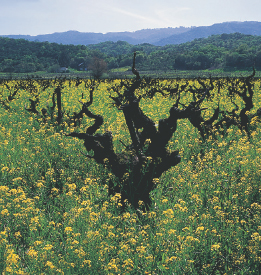
Mustard being grown as a cover crop between rows of 100-year-old Zinfandel vines in Sonoma County, California. Mustard can help to control virus-spreading nematodes in the soil.
In sickness and in health
The vine is subject to so many ailments and pests that sometimes one wonders how it manages to survive at all. One Oregon vineyard lists its particular local enemies thus: ‘Crown gall, weevils, thrips, birds, bears, other critters.’ Another vineyard, this time in California, knows when the grapes are ripe because whole tribes of raccoons come and eat them. In Germany wild boar can be a problem; in Australia it’s kangaroos; in South Africa, baboons. Deer, rabbits and birds are universal predators on defenceless grapes. That is, of course, assuming that the grapes succeed in surviving downy mildew (which likes warm, wet weather), powdery mildew (which prefers dry weather), early bunch stem necrosis and grey rot, and that the vine manages to avoid black goo, Pierce’s disease, fan leaf virus, leaf roll virus and eutypa or ‘dead arm’ (after which d’Arenberg’s Dead Arm Shiraz is named), to name only a few.
Vine diseases can be bacterial, fungal, viral or phytoplasma; some are controllable, some preventable, some deadly. Some of the fungal diseases, including downy mildew, powdery mildew, anthracnose and grey rot, can be controlled with the use of fungicide sprays, of which Bordeaux mixture, a solution of lime, copper sulphate and water, is the oldest.
Virus diseases like fan leaf and leaf roll are spread either by cuttings or by nematodes in the soil. Even vines that are virus-free when planted tend to become infected – though they certainly stay healthier longer than young vines that have no pretensions to being virus-free. (As one Burgundian puts it, ‘You’ll stay in better shape if you go to Africa healthy than if you go there unhealthy.’) But then even the term virus-free is only relative: of about 20 identified viruses only six are really dangerous, and it is those of which virus-free vines are free. When it comes to the others, vines must take their chance.
Pierce’s disease, on the other hand, is a bacterial disease which kills vines fast. It is one of the main targets of national quarantine regulations, and is spread by an insect called a sharpshooter which has sadly little respect for national boundaries; the disease is so far confined to certain parts of the USA – including Napa, although it seems to be under control – and Central and South America, but while the blue-green sharpshooter is relatively manageable and home-loving and seldom strays more than 15m (50ft) from streams, the larger and more mobile glassy-winged sharpshooter, which originates in the Southern states of the USA, is beginning to encroach into Oregon, Napa and Sonoma, and is capable of spreading Pierce’s disease very fast and very efficiently. Sharpshooters are found in Europe as well. European growers are not looking forward to an encounter with Pierce’s disease.
Other insects, this time leaf hoppers, spread flavescence dorée, one of a group of phytoplasma diseases known as grapevine yellows. This will kill young vines and weaken old ones, and is potentially even more destructive than phylloxera, partly because of the speed with which it spreads, and partly because there is no treatment. Northern Italy has suffered greatly from it; it is found in France, Germany, Switzerland, Australia, New York State and elsewhere.
The only route open to growers is to control the leaf hopper population; this can be done by spraying insecticide. But here one comes up against one of the main tenets of modern viticulture: that biodiversity is a good thing, that sprays of all kinds should be reduced as much as possible, and that it is desirable, where possible, to move in the direction of organic viticulture. Try telling that to the authorities in Burgundy who took a very quality-conscious biodynamic grower to court for refusing to spray against leaf hoppers because it would wreck his biodynamic status. Neighbouring non-biodynamic growers would be a lot more concerned about his pristine vines being a haven for the leaf-hopper, and thus a source of grapevine yellows infection. A cause célèbre that will recur.
It should also be noted that the role of all insects may not be fully understood. For example, we now know that yeasts are spread by wasps, which harbour Saccharomyces cerevisiae in their gut, passing it to the grapes when they bite into them. Birds and other insects can also spread yeasts; wasps also carry other microorganisms which they transfer to the grapes, and which can add flavours to the wine. And then there are ladybirds. Lovely things, ladybirds: they eat aphids and mealybugs, and may be encouraged by growers because of this. Trouble is, if they get into the grapes at harvest, and into the presses, they produce IPMP (2-isopropyl-3-methoxypyrazine) which taints the wine with a bitter, herbaceous flavour detectable at about one part per thousand, and which is ineradicable. Ontario, in Canada, lost a lot of wine to ladybird taint in the early part of the century. Potassium metabisulphite seems to be an effective deterrent to the insects; otherwise it’s back to insecticides, which rather defeats the object.
A YEAR IN THE VINEYARD
Work in the vineyard follows a basic pattern the world over, but the timing of each operation is dependent on both the prevailing climate and the weather conditions of the year. Winter: the leaves fall, the sap descends and the vine becomes dormant. Pruning can be done at any time during the winter. Spring: the sap starts to rise, and the first signs of growth appear: the young vine must be protected against frost from now until early summer. Sprays may be necessary to protect the buds against pest and disease, though organic and biodynamic growers use other methods. Ploughing and hoeing aerates the soil and clears weeds; fertilizer may be applied. As the ground warms up, new vines can be planted. Once the vines begin to shoot, the new growth needs to be tied to the wires, otherwise the foliage would shade the fruit and prevent it from ripening; the final trellising (here) takes shape. Summer: eight weeks after budbreak, the vine flowers for about 10 days and then the fruit sets; cold or wet weather at this time can cause poor fruit set and thus reduce the quantity of the harvest. Summer pruning, or leaf plucking, may be necessary to allow more sunlight to reach the fruit. At véraison (the point at which the fruit changes colour) a green harvest may be done to reduce the size of the crop, and superfluous clusters removed. Netting or bird scarers may be used to protect against bird damage. Autumn: picking usually begins in September/October in the northern hemisphere, or February/March in the southern, but climate change is bringing these dates forward.

Budbreak on a Cabernet Sauvignon vine; this normally occurs 20–30 days after the sap starts to rise in the spring.
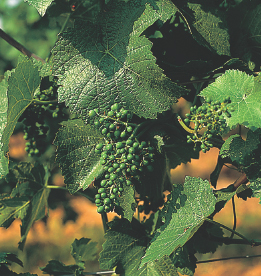
Young Pinot Noir clusters begin to appear a few weeks after flowering. Rain and cold may yet prevent the young berries from developing evenly.
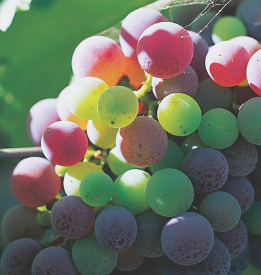
Cabernet Sauvignon changing colour at véraison; this marks the beginning of the final ripening stage and occurs about 50–70 days after flowering.
BIODYNAMISM: NEW AGE HIPPIEDOM OR SOUND SCIENCE?
Biodynamism is the most extreme position taken by growers who follow the path from conventional viticulture to integrated management to organic. It is based on the theories of Rudolf Steiner (1861–1925), and emphasizes the importance of working with the movements of the planets and cosmic forces to achieve health and balance in the soil and in the vine.
It is different in kind as well as in degree from organic viticulture. Biodynamism uses natural herbal, mineral and organic preparations in homeopathic quantities: key applications are of horn dung, horn silica and dung compost. The first is made by burying a cow’s horn filled with dung over the winter; it benefits the roots. Horn silica again involves a cow’s horn, but this time filled with powdered silicum and buried over the summer; it aids photosynthesis. Dung compost is self-explanatory but not simple, since ideally every vineyard should have its own recipe, to reflect its unique needs; it helps the soil.
These preparations are mixed with water and ‘dynamized’ by stirring them first one way and then the other: horn manure should be stirred into warm water if possible, and stirred briskly for precisely one hour. This should be done by hand, not by machine: one of the leading exponents of biodynamism, Loire producer Nicolas Joly, compares the patterns created in the water to the patterns of Celtic art. ‘The air is unceasingly taken into the spirals and intensifies all sorts of exchanges,’ he says. The solution should then be applied at sunrise to the leaves of the vine, in quantities of just 40–50 litres of water per hectare.
The notion that briskly stirring a liquid introduces air is not strange to the many winemakers who stir the lees of maturing wine: they know that creating a spiral gives a different result to moving a stirrer backwards and forwards. The suggestion that this somehow relates to some lost Celtic wisdom might, however, upset those who have problems accepting the odder elements of biodynamism. Joly also stresses that manure must be buried in a cow’s horn rather than a bull’s horn because the former accentuates the ‘primordial feminine’, and when choosing manure, you should take into account not just the diet of the animal (for choice, one third leaves, one third roots and one third hay) but also its temperament: horses, he says, are dominated by heat.
What is also controversial is the stress on the influence of the stars and planets on the growth and well-being of the vine. Different times of the day and different phases of the moon are held to be suitable for different activities and different remedies: growers turning to biodynamism must be prepared to be out in their vines at three or four in the morning if required. It is an extremely dedicated, expensive and time-consuming way of growing grapes.
Perhaps the oddest thing of all is that it seems to work. Biodynamism seems to produce wines with purer flavours and better balance. Indeed, the argument has moved from whether biodynamism works to why it works, and many growers are now taking a more scientific approach – which in the long run can only be to the benefit of biodynamism.
Is the success of biodynamism due to the intensely detailed attention biodynamic growers pay to their vines and soil – in other words, would that degree of care pay off whether you were biodynamic or not? What you put on the soil must make a difference: Dominique Lafon of Domaine des Comtes Lafon in Burgundy found that after he went biodynamic the acid balance returned to his wines after just three years. ‘You can feel in the wine that the vine is healthy,’ he says. Soil expert Claude Bourguignon finds that microbial life in the top 30cm (12in) of soil is much the same in an organic vineyard as in a biodynamic one. But, he says, if you go deeper than this, the microbial life in a biodynamic one is far greater. Reactions between the roots of the vine, which can descend 30m (100ft) into the subsoil, and the microfauna around them, generate the oxygen and minerals that are vital for a strong, healthy plant. Deep-rooting vines give thicker, stronger grapeskins, and thus more resistance to disease, more flavour, and longer maturing wine.
For many biodynamic growers in France, one of the attractions of the system is that it enables their wines to reflect their terroir: the application of standard commercial preparations, they fear, has a ‘dumbing-down’ effect on the individuality of each vineyard.
Going organic
How feasible is it for all growers in all wine regions to adapt either organics or biodynamism? To be realistic, not very. The happy situation we described at the beginning of this chapter, with vineyard and cellar viewed as a whole, is still found in only a small minority of estates. But lip service is paid to it in very many more, and most producers, apart from die-hard industrial bulk producers, move in the direction of sustainability as and when they can.
Most producers, one has to remember, are constrained by the necessity of having a given amount of wine to sell every year. Losing a third of the crop or more to rot or mildew is not financial good sense. Few of us non-wine producers, either, would willingly risk a third of our income for the sake of an ideal. Warm, dry climates are best suited to thoroughgoing organic production, and regions like the South of France, Chile and California have a built-in advantage in not suffering from the humidity that can lead to mildew, rot and other ailments. In cooler, wetter regions like much of Germany, for a grower to go organic may mean losing an estimated 30 per cent of his crop in many years. Total loss is not unknown. Sustainability, lutte raisonnée, integrated management, are preferable for most. Sustainability might involve using pheromone capsules against insect pests rather than pesticides; you might plough and hoe your vineyards; you might encourage wildlife corridors and biodiversity; you might plough cover crops between the rows and then plough them in. Mustard can help to control nematodes; other crops, like clover, can unfortunately encourage leaf hoppers. The increase in ground cover in vineyards and the resulting increase in the leaf hopper population is certainly a factor in the spread of grapevine yellows. Biodiversity works both ways.
When you start to interfere in an ecosystem, even though you act with the best possible intentions, you cannot be sure of the effects of your actions. If, when planting a vineyard in virgin land, you spray against a pest, you may find you have destroyed a predator of that pest. Organic and semi-organic producers prefer to introduce predators to control pests – in Chile, a coleopter called Ambrysellus can be used against red spider; ladybirds can be used against aphids (see above). (This is, of course, just another form of interference, but so far the results seem to be more beneficial to the vine.) Sexual confusion (the use of pheromones to control populations of certain insects) can be used against grapeworm and other pests.
All this is far more work than simply loading up a tractor with a container of chemical spray. It requires far closer study of your vineyards, and far more time spent on seeking solutions, but more and more serious growers seem to be prepared to make the commitment. No doubt many more would go fully organic but for the devastating reality of rot and mildew. Bordeaux mixture is permitted under organic rules, but presumably only for pragmatic and historic reasons, since it eventually builds up in the soil and can cause copper toxicity.
Full-blown organic viticulture forbids the use of any industrially synthesized compound, though the details vary from organization to organization. Fertilizers must therefore be natural – compost and manure – and the addition of these is also normal in integrated management.
Do organic methods produce better wines? One feels they should; yet too many wines with organic accreditation are poor quality. The range of quality is in fact exactly the same as is found in non-organic wines: from disappointing to very good. Clearly you can be a careful vine grower without being a good winemaker as well; whatever the reason, an organic logo on a label is not in itself a guarantee of a good wine.
The optimum crop
Optimum, you notice, not biggest, smallest or even best. Frankly, some grape varieties give better results with higher yields, some don’t. And there’s no doubt you can cut the yields too low and quality can actually suffer. Winemakers, like everyone else, have to cut their coats according to their cloth, and it is sad but true that some possible improvements in quality are not initiated, particularly in less fashionable appellations, because the improved wine would not fetch a substantially higher price, even though the investment might be substantial. On the other hand, among fashionable appellations and fashionable producers the sky seems to be the limit, be it in the lengths they will go to to improve their wines, the amount of money they will invest, or the prices they can charge. Life is no fairer to wine producers than to anyone else.

The direction of the rows of vines can make a big difference to how your grapes ripen: you might want to protect the vines from the prevailing wind; you might want to let the wind in, for greater ventilation; you might want more or less sun exposure. These vines are in Marlborough, New Zealand and face north–south. Most regions show little consensus, but the most common directions are variations of north–south.
Yields
The rule used to be so simple: it was that in wine, quantity and quality did not go together. Higher yields equalled lower quality, and vice versa. We have, in recent decades, explored both extremes. Work on canopy management, emanating originally from New Zealand, demonstrated that yields could rise more than anyone had thought and still give ripe grapes; garage wines, originally from the Right Bank in Bordeaux, took lesser terroirs, paid extravagant attention to the vines, and made super-concentrated wines from tiny yields, aged them in extravagant amounts of new oak and charged extravagant prices for them.
Where are we now? Growers of New Zealand Sauvignon Blanc have been urged, in recent years, to restrain their yields to avoid a damaging glut. Many want to do so anyway, because they feel that very high yields contribute to banality of flavour.
And garage wines? Where are they? Either in the mainstream (Valandraud on Bordeaux’s Right Bank equipped itself with better terroir and is now a Grand Cru Classé) or out of the picture and regarded almost as a recent historical oddity.
It all comes down to ripeness and concentration. It all depends on your terroir and what sort of yield you can ripen; and also on what sort of wine you want to make. Frederic Panaiotis of Champagne Dom Ruinart, for example, chooses less ripe Pinot Noir for his prestigious Dom Ruinart Rosé than he does for the more fruit-forward Ruinart Rosé, because it sits better with the Chardonnay in the blend. Yields can be higher in Champagne than further south on the Côte d’Or because the desired end result is different; likewise yields are lower (or should be) for a Grand Cru Burgundy than for a Village one.
What has become clear is that you don’t make high-quality wine merely as a result of having low yields. In practice, most (though not all) of the world’s great wines come from low-yielding, low-vigour vines – but while low yields are associated with high quality, they do not in themselves confer it.
It’s a question of getting the right amount of sunshine on to the leaves and grapes, and thus encouraging optimum ripening. Low-yielding, low-vigour vines have small, open, leaf canopies, and thus good leaf and fruit exposure to the sun. (This may be one reason why old vines, with their less vigorous leaf growth, give such good grapes.) Shade means less sugar, less flavour, often a streak of unripeness and, in red wines, less colour.
If you halve the yield, you may double the price of the wine, but not necessarily the quality: there is an optimum yield, which is the point at which the vineyard is in balance. That point is different for every grape variety in every vineyard in every vintage; not surprisingly, relatively few vineyards are in perfect balance.
Above and below that optimum yield the law of diminishing returns sets in. Reduce your yields in the vineyard too harshly and there will not be the increase in quality to justify the reduction in quantity. Increase your yields too generously and eventually quality will fall faster than quantity rises as the wine becomes increasingly dilute. To take the example of Riesling grown on steep slopes in the Mosel Valley: there the turning point for quality is said to be between 120 and 150 hectolitres per hectare; after that quality drops. Even the lower of those figures is far more than a good Mosel grower will admit to; but then asking a wine grower about his yields is a little like a doctor asking a patient how much he drinks. The doctor makes a mental adjustment of the figure he is given, and perhaps we should do the same.
Yield is expressed in various ways around the world. Some countries favour tonnes of fruit per hectare; others prefer tons per acre. Many European countries express yields as hectolitres of juice per hectare of vines. It is difficult to convert hectolitres per hectare to tonnes per hectare with precision because, of course, much depends on how much juice is extracted from the grapes; in fact, more efficient extraction of juice is one reason (though by no means the only one, or even the main one) why vineyard yields have seemed to be rising in recent years. Roughly speaking, one metric tonne of grapes will produce between 550 and 750 litres of juice, depending on how heavily they are pressed. White grapes may yield less than red, because very gentle pressing is essential for many varieties if harsh flavours are to be avoided. Riesling is an example: its thick skins, if pressed hard, will yield coarse-tasting phenolic compounds. But as a rough guide, one tonne per hectare is more or less equal to seven hectolitres per hectare. One ton per acre is more or less equal to 17.5hl/ha.
European wine laws, though not usually those outside Europe, impose limits on yields for appellation wines. France, however, also has the plafond limite de classement, or PLC which allows the yield in any given year to be raised by as much as 20 per cent or even more over the basic yield. This is why yields in Bordeaux, even for leading appellations, may be as high as 55 or 60hl/ha, when the official base yield is just 45hl/ha. Many, many vineyards around the world give yields that are too high for optimum quality. In Alsace, for example, between 1945, when the appellation was set up, and 1975, when the first Grand Cru vineyards were established, the basic permitted yield was increased two-and-a-half times. In Germany, whole lakes of poor quality Müller-Thurgau are produced at 300hl/ha.

Geneva double curtain trellising in action in Argentina. Systems like this are being tried around the world, but they’re not suitable for all situations.
Density of planting
What is crucial, however, is not the yield per hectare or acre but the yield per vine. This is based on the number of bunches per vine, and the weight of the bunches, both of which are a direct result of viticulture – planting density, pruning, pest control and other vineyard management policies – and, of course, the weather.
Planting density can vary hugely, even within countries and regions. In Spain’s Penedès, it varies from 800 to 2000 vines per hectare; in Australia and New Zealand it can be as low as 1000 per hectare in some vineyards or as high as about 4000/ha in others, with the odd experimental planting of 9000/ha; in California the traditional figure is about 1125/ha. Chile’s usual figure is about 3000/ha, though one company is trying 25,000/ha in the South. In Burgundy’s Côte d’Or, there are usually 10,000/ha, though the Domaine de la Romanée-Conti is experimenting with 16,000/ha; in Bordeaux’s Médoc, there are usually 10,000/ha while in Entre-Deux-Mers this can go down to 2700/ha.
Generally growers are moving towards higher densities as part of the search for quality, but the choice of density ideally depends on the soil. In fertile, irrigated soils where the vines are vigorous, each vine will need enough room to spread its canopy out: a vigorous canopy cramped into a small space means shaded leaves and fruit. On less fertile soils, quality can improve if the vines are more crowded and yet produce no more wine per hectare. In Chile, Bordelais winemakers have often attempted Médoc-style higher densities; and, interestingly, these have not always proved successful. Better quality has often been obtained from lower densities. But densities have changed over time in Europe as well: Ancient Roman viticulture used to have some 50,000 vines per hectare of vineyard.
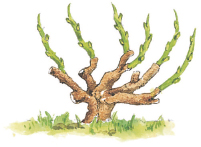
Gobelet A head-trained, spur-pruned system traditional to Mediterranean countries. The vine forms a low bush, which shades the fruit from excessive heat and encourages the grapes to ripen more slowly.

Mosel arch A head-trained, cane-pruned system used in Germany’s Mosel region. Each vine has its own supporting post, with wires to which the foliage is tied.
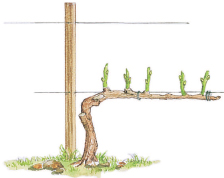
Cordon de royat A cordon-trained, spur-pruned vine, this is the system used in Champagne. The spurs are the short pieces of cane left by the pruner.
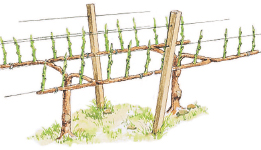
Lyre A cordon-trained system in which the canopy is horizontally divided.
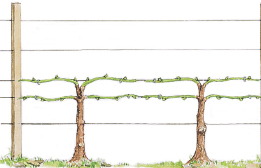
Scott Henry In this system half the shoots are trained up and half are trained down. In high-vigour sites a larger crop can be ripened, with higher sugar levels and lower acidity.
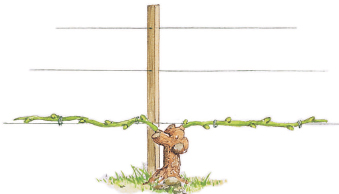
Double Guyot An example of a head-trained, cane-pruned vine. At the end of the season the canes will be cut off and new ones selected for the next year.
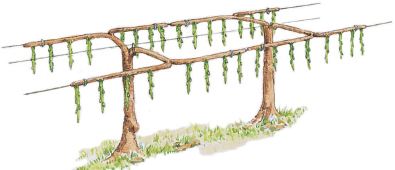
Geneva double curtain A cordon-trained system with the canopy horizontally divided and all the shoots hanging down. In high-vigour sites vines can ripen more fruit this way, though grapes may get too much sun, leading to phenolic, oily-tasting wine.
It is often the method of vineyard management that, rightly or wrongly, determines the density of planting: 19th-century European viticulture, with a vine density of 10,000–15,000 per hectare of vineyard, was designed around the horse, and how it was used to work the land. In Chianti, until quite recently, the usual density was 2700 vines per hectare, and was designed around the tractor.
Co-planting
All vineyards, once upon a time, were co-planted. Varieties were mixed up any old how; sorting them out and planting them block by block was one of the great advances of the second half of the 20th century. It meant that each variety could be picked at optimum ripeness and treated individually.
But a few old, mixed vineyards survived: in Vienna, where the resulting wine, Gemischter Satz, was a local tradition; and in the Douro, in odd corners where the seductive replanting subsidies of the World Bank did not reach. Now mixed vineyards are the new big thing. Gemischter Satz is a fashion rather than a fading memory, and its proponents insist that while you lose optimum ripeness for each variety, you gain harmony and cohesion in the wine. In the Douro, wines from the old vines that escaped uprooting sell for enormous prices, and if you happen to own such a plot, sharp-eyed winemakers will be knocking on your door three times a day.

An alternative approach to canopy management is minimal pruning, seen here in Napa, but now largely gone out of fashion: all manipulation of the canopy is jettisoned, and pruning is stopped. The vines look alarmingly shaggy, but the idea is – or was – that over several years the vine finds its own balance. Questionable.
Where else might mixed vineyards survive? Probably in many places. The constant trickle of rediscovered old varieties in Italy and Spain suggests the presence of the sort of mixed plantings in which such discoveries might be made. In Alsace, Marcel Deiss is a longtime believer in field blends. And some of California’s more respected reds are from old field-blend vines.
Canopy management: letting in the sun
Canopy management embraces pretty well everything one might do to a shoot or a leaf, from tying it in a particular place on a trellis to positioning it in the sun to cutting it off. It thus covers all aspects of pruning and training vines. The purpose of it is to get vines into that coveted balance in which they will produce the optimum yield of optimum quality grapes.
It takes about eight leaves to mature a cluster of grapes. But those eight leaves must have sunlight; if they are shaded by other leaves, the vine will produce too little sugar and the crop won’t ripen. (Dense canopies also encourage humidity and therefore rot and other ailments.) The answer is not necessarily to prune the vine hard: if you do that to a vigorous vine it will simply produce an even denser canopy, with more shading effect and consequent green flavour. Leaf plucking, or removal of excess leaves in summer, can help this. If a vine is in good balance, the weight of prunings cut off in winter will be between one-tenth and one-fifth the weight of the crop of grapes. But growers have to bear in mind that changes in viticultural methods won’t show any benefits for a couple of years: with vines you’re always working for the next vintage but one.
Different trellising systems are being tried out for many varieties, all over the world. For example, in New Zealand a combination of adequate sunshine, yet cool climate and soils of often high potential vigour can give problems of underripeness. In such conditions the vines grow fast and furiously and the canopy ends up shading the fruit: the result is green, harsh, under-ripe flavours. Irrigation and the application of fertilizers only exacerbate the problem. Elaborate systems like Scott Henry have been successful in producing riper grapes.
With warmer summers and higher alcohol levels, there is an increasing need to reduce the amount of sun reaching the grapes. Leafplucking may now only be done on the less sunny side of the row, and more shading encouraged. At the very least, this can prevent sunburn, which bakes the aroma out of the grapes and gives harsh flavours in the wine.

Drip irrigation of young vines in New South Wales, Australia. Each vine has its own controlled water supply, and soil humidity can be regulated. Nutrients can also be delivered to the vine this way.
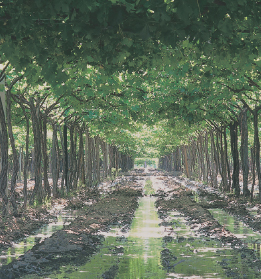
Flood irrigation in Argentina. This is cheaper and far less controllable: it cannot be regulated to induce the sort of mild water stress that is desirable for top quality, but can control phylloxera.
Pruning and training
The traditional forms of trellising used in France, Germany and some other parts of Europe have the general name of Vertical Shoot Position, or VSP. This term embraces everything from gobelet to the pergolas used in parts of Italy, and includes the guyot and cordon methods.
The shoots are trained upwards as they grow, and the fruit positions itself towards the bottom of the canopy. Europe’s low potential vigour soils produce relatively open canopies with this system, and leaf plucking and correct pruning to keep the vine in balance are generally enough to produce canopies of the required openness. In high vigour sites, on the other hand, VSP systems may lead to excess shading.
Newer systems are masterpieces of architecture. Canopies are divided vertically or horizontally, or both: some shoots may be trained upwards while others are, with difficulty, trained downwards.
Most systems are either head or cordon trained, and either spur or cane pruned. In head training the spurs or canes that produce the fruit-bearing shoots are positioned close together at the top of the trunk. In cordon training there are one or two long arms from which the fruit-bearing shoots will grow. These are part of the vine’s permanent structure. In spur pruning, all the canes are cut back to one or two buds each spread along the cane. In cane pruning, one or more canes from a previous year’s growth are left behind at pruning, though cut to the required length. These canes bear the buds that will shoot to produce fruit.
Green harvest
If your crop of grapes is too heavy – and many are – you can go through the vineyard during the summer and cut off the excess clusters. The idea is that the remaining clusters will have more concentrated flavours. It is not an ideal solution, and does nothing to get the vine into balance. The ideal is to have the vine producing the right quantity in the first place, but this end is extremely hard to achieve – and since frost, disease and hail can all reduce the size of the crop, many growers like to have a few extra clusters on each vine as an insurance policy. A green harvest just after véraison, to remove those green grapes that are clearly lagging behind the rest, is also a way of ensuring a more homogeneously ripe final crop. This is particularly useful if poor weather dragged out flowering over a long period.
Irrigation
It used to be said that vines had to struggle to produce great wine. The trouble is, vines that have to struggle too much produce wine that is very far from great; and the main cause of stress in vines is lack of water. Drought simply causes the vine to shut up shop: photosynthesis, and thus the ripening process, ceases. A little water stress can be a good thing, but not too much.
Managing irrigation properly is one of the greatest skills a grower must learn. Traditionally it was banned in European countries, but it is creeping in through the back door, and there is a case for it if hotter, drier summers are to become more common: it can nudge grapes to full physiological ripeness and prevent the vine shutting down and giving grapes with unripe, green flavours.
In much of the New World rainfall patterns are different from those in Europe. If you get no rain at all between spring and autumn, as is often the case, then obviously you have to irrigate to be able to grow vines. Burgundy, for example, gets 60 per cent of its annual rainfall during the growing season: Napa gets just 15 per cent. But trying to use irrigation to replicate European rainfall patterns in the New World doesn’t necessarily work either: that’s what leading Bordeaux winemakers Bruno Prats, formerly of Château Cos d’Estournel, and Paul Pontallier, winemaker at Château Margaux, originally tried to do at Domaine Paul Bruno, their property in Chile. They had thought that imitating a wet spring, followed by water stress up to the harvest, would produce better quality; it didn’t. ‘It was a huge lesson in modesty,’ they say.
BOTRYTIS CINEREA: A BETTER KIND OF ROT
Not all rot on grapes is undesirable. Botrytis cinerea, when it affects ripe white grapes, produces luscious sweet wines such as Sauternes, Tokaji or Beerenauslese. (It destroys the colour of red grapes although very rare red Beerenauslese is made.) Ironically it is the same fungus that, in unripe grapes, causes grey rot or botrytis bunch rot, which is the biggest headache for any grower coping with a damp climate.
Grapes affected by noble rot turn golden, then pinky purple, then go brown as they dehydrate. Eventually they shrivel and become covered in a grey mould. The fungus metabolizes both sugar and acids, generally reducing the sugar content of the grape by one-third, tartaric acid by five-sixths and malic acid by one-third. But the loss of water, which is partly the effect of the fungus and partly the effect of evaporation as the skins are punctured by the fungus, results in great concentration of what is left.

Heavily botrytized Sémillon grapes at Ch. Rieussec in Sauternes. These grapes will make dense, lush golden sweet, and expensive, wines. .
But that is not the whole story. The chemical make-up of the grape juice is changed by the fungus, and glycerol, acetic acid and enzymes such as laccase are formed. The result is that wines made from botrytis-affected grapes have a flavour utterly different to that of other sweet wines, and combine it with such longevity that sometimes they seem almost immortal.
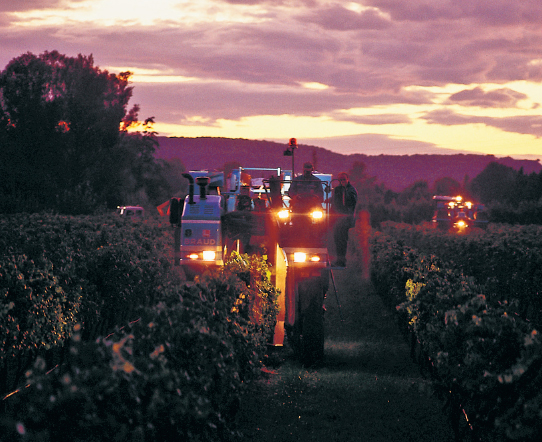
Machine harvesting of Chardonnay in Narbonne, Languedoc, France just before dawn. Picking at night like this means that the grapes are cooler when they arrive at the winery, oxidation can be kept to a minimum, acidity and freshness are maximized, and no extra cooling is needed at the winery.
Growers see irrigation as one of the more effective tools for adjusting what nature has given them: ‘a way of imitating great terroir’, as one puts it. But there are no easy answers about how best to do it. Overgenerous irrigation, for example, simply increases the amount of wine you make, by effectively diluting it with water. Producers of bulk wine in places like California’s Central Valley or Australia’s Riverland may irrigate relentlessly to try to keep the soil full of water because quantity is their overriding consideration, not quality. What may be cleverer from the quality point of view is to introduce deficit watering just after flowering. This means giving the plant only enough water to grow sufficient leaves and shoots to ripen a crop; it causes mild stress which causes vegetative growth to slow and then stop, but not enough to stop photosynthesis and the ripening process. It also seems to affect cell division inside the grapes, so you get smaller berries. This means a higher proportion of skins and pips to flesh, and thus more colour, flavour and intensity.
The usual method of irrigation is drip irrigation. Thin rubber or plastic tubes run along the rows of vines, delivering carefully controlled quantities of water, drop by drop, to each vine. Ideally, constant monitoring of the humidity of the soil – and even of the pressure in the leaf cells, and the daily expansion and shrinkage of the vine trunk – enables the quantity of water delivered to be correctly regulated. In Chile and Argentina, however, some vineyards still rely on the more old-fashioned ditch irrigation, in which ditches dug at intervals through the rows are periodically flooded. Obviously this is far less controllable, and it is less common now that plantings are more likely to be on slopes. Certainly one of the problems of drip irrigation is that it encourages root growth near the surface of the soil, when what all growers want is deep roots that search out nutrients at lower levels.
With water in increasingly short supply in some places, efforts are being put into reducing irrigation to a minimum. Partial root drying is one way: you irrigate on one side of the row, then the other. Another method is to bury the irrigation pipes, reducing evaporation. Controlling irrigation to the last drop not only saves scarce water, but can improve the pH and thus the balance of the wine.
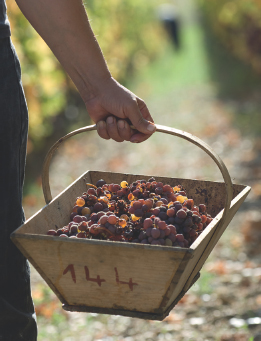
Heavily botrytis-affected Sémillon grapes being bought in from the vineyard at Château d’Yquem in Sauternes, probably the world’s most famous sweet wine producer.
Finally, picking
The grape harvest may conjure up an image of jolly pickers tucking into rustic banquets washed down with last year’s wine, but the reality is usually sunburn and backache – or cold fingers and rheumatism, if you happen to be picking in November or December at the northernmost reaches of the northern hemisphere. (In Germany, Canada and the East Coast of the USA, picking may even take place on a freezing day in January, if you are aiming to make Icewine. For this, the grapes are picked and pressed while they are still frozen; very concentrated, sweet juice runs from the press, and the water stays behind in the form of ice.)
And in many regions, the grape harvest takes the form of one man on a mechanical harvester, perhaps picking in the cool of the night before the morning sun warms the grapes too much for good winemaking.
Some producers distrust mechanical harvesters but there is no universally best method of picking, and how you pick your grapes must be governed by the dictates of ripeness, the weather and the type of wine you want to make. Plus, of course, your budget.
Picking at optimum ripeness is, whatever the climate, the most difficult to achieve. A cool spell in late summer may hold the grapes back, only for a hot week to accelerate them to the brink of overripeness. In those circumstances you need to act fast, since overripe grapes will produce soft, flabby wines which you will have to acidify (if you’re allowed to). Or the grapes may be ripening so dreadfully slowly that you fear they will never get there at all, and perhaps rain is forecast. Do you then pick them before they are properly ripe, hoping to chaptalize – add sugar – (if you’re allowed to) to compensate for the lack of sugar, or do you hold your breath and wait? One thing you should not do is pick in the rain: it is equivalent to simply pouring water into the juice.
When you have to pick fast, mechanical harvesters come into their own. They can work round the clock, and in hot climates picking at cool nighttime temperatures is a quality plus. They work by repeatedly hitting the vines so that the fruit, either in the form of loose berries or whole clusters, falls on to conveyor belts. Producers who use machines say that quality is not compromised provided that the vines have been properly prepared first, which usually means removing unsuitable fruit and clearing away any vegetation that might get picked as well. Inevitably there is some risk of bruising the fruit, and if the grapes have to travel a long distance to the winery there may be a risk of excessive skin contact with juice from broken grapes, but the effects of oxidation can be minimized with sulphur dioxide. (See In the Winery, here.)
Machines are crucial where labour is scarce or expensive, but they cannot select the best grapes in the vineyard the way that well-trained pickers can. In Sauternes, and for Germany’s Beerenauslesen and Trockenbeerenauslesen, where it is essential to pick selected grapes at particular levels of noble rot, you have to have pickers making several passages or tries through the vineyard. Like Sauternes, Monbazillac also relies on rigorous selection in the vineyard if the grapes are to achieve the super-ripeness needed for sweet wines. Nevertheless, mechanical harvesters were permitted for a period here until they were phased out from 1994. This is just one example of how a region’s laws can favour the lazy until quality producers demand a change.
Other things being equal, however, there are no quality differences implied in machine versus hand picking. Machines are far gentler than they used to be, and not all human pickers are good at following instructions.
IN THE WINERY
Winemakers have got into the habit of saying ‘wine is made in the vineyard’. Does this mean that as soon as the grapes arrive at the winery the die is cast? If the style and quality of the wine is inherent in the grape, is there nothing the winemaker can do to improve upon the raw material? Can he only destroy, not create? Well, obviously not. The winemaker still has choices, even if he chooses, for quality reasons, to do as little as possible. He can stress flavours or suppress them; he can coax a wine to precocious maturity or hold it in a state of arrested development. But if he does nothing but sit on his butt reading the newspaper, the best grapes in the world will swiftly turn into vinegar. The huge amounts of money being invested in new wineries all over the world suggests that something important is going on in those vats.
The first thing a decent winemaker must have is a vision of the style and flavour he wants to achieve in his wine. Indeed, the vines should have been cultivated with that vision in mind. In the winery he may favour minimal intervention, or else every technique under the sun, including the use of selected yeasts, must concentration, oak chips or new oak barrels, pre-fermentation cold maceration and goodness knows what. There is no New World–Old World pattern to winemaking any more. Everywhere, the most refined technology goes hand in hand with a new awareness of the past, as traditional techniques are found, after all, to have something to say for themselves.
Yeast: wild or cultured?
The winemaker may allow the native yeasts, present in the cellar and on the grape skins, to ferment the must to wine, or he may prefer the greater predictability of cultured, selected strains of yeast. If he chooses the latter, he may further choose a yeast that emphasizes particular aromas and flavours or one that is neutral in its effect on aroma.
The native yeast population in any cellar or vineyard will contain many different strains, and the balance of strains will vary from year to year. Winemakers who rely on wild yeasts welcome these differences, and the subtle year-to-year variation they give to the wines. The wine may also gain greater complexity from this varied population, though the relative unpredictability of wild yeasts means that there is a small risk of the fermentation sticking before it is complete, and refusing to restart. This can result in bacterial spoilage, and at best means that the wine will be sweet with unfermented grape sugar (residual sugar) where none was intended. If cultured yeast is used, the wild yeasts must be killed by the addition of sulphur to the must: sulphur is used throughout the winemaking process as an all-purpose antioxidant and antiseptic.
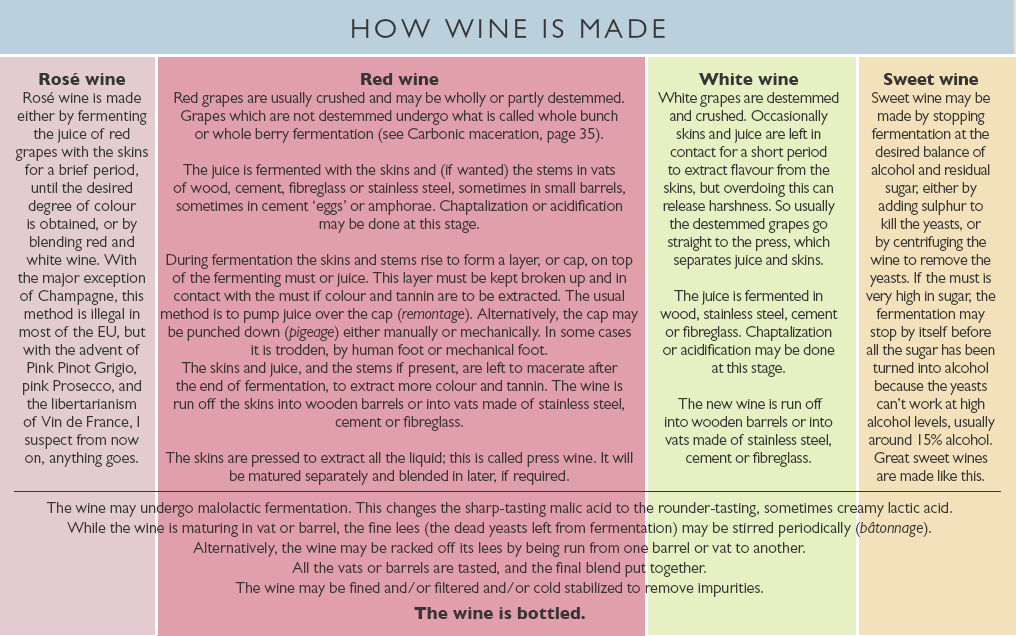
Wild yeasts, of course, always come from somewhere. Research is being done on how far the action of wasps might spread different families of yeast from one vineyard to another; at the moment it looks as though the same families of yeasts will be found in the same vineyard over a number of years – which equates to millions of yeast generations. Yeasts can also be brought in on new oak barrels, and research indicates that this is how some families of yeast have arrived in some New World vineyards.
Fermentation temperature
Controlling the temperature of fermentation was the 20th century’s single biggest advance in winemaking. Wines fermented at cool temperatures retain their aromas, freshness and varietal character; those fermented too hot lose these desirable attributes and taste tired and stewed.
However, just because cool is good, colder is not always better. The temperature has to be above 10°C (50°F) for yeasts to work effectively, althought there are rare strains of yeast which can operate at lower temperatures, sometimes barely above freezing point. Between 12° and 20°C (54° and 68°F) is normal for white wine, and temperatures at the lower end of this scale favour the development of floral aromas, leafy perfumes and assertive fruit flavours; reds are usually fermented hotter, at between 25° and 30°C (77° and 86°F), to extract colour and tannin. The vast majority of fermentation takes place in large vats of stainless steel, cement or wood, though a few properties ferment reds in oak barrels, a quite common practice for whites. Amphorae or concrete eggs (see below) can also be used.
Chaptalization and acidification
It takes approximately 18 grams of sugar in 1 litre of must to produce one degree of alcohol. If the must is insufficiently high in sugar, more can be added in the form of beet or cane sugar or must concentrate, either before or during fermentation. The process is known as chaptalization, and is legal (and normal) in northern Europe and cool climates elsewhere, though illegal in the warmer climates of southern Europe. In southern Europe, however, ‘enrichment’ by the addition of concentrated grape must is often permitted, and has the same effect of raising alcohol levels. There are legal limits on how much the alcohol level may be raised by chaptalization or enrichment.
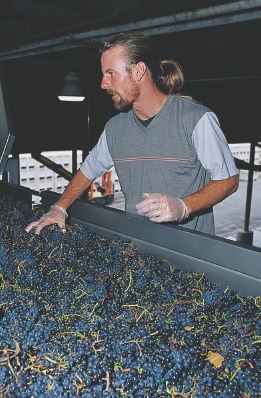
A sorting table, like this one at Robert Mondavi’s Carneros winery in California, is common at leading estates. The first selection of grapes is done by the pickers in the vineyard, but when the grapes arrive at the winery they must be checked again, and any unhealthy or underripe clusters removed. Some estates also use vibration, laser beams and goodness knows what else to remove every imperfect berry. Which makes you ask: What is a perfect berry?
Acidification is the warm climate counterpart of chaptalization: adding acidity to compensate for lack of it in the must. It may be added before fermentation or afterwards, but if you want it to blend subtly, adding before fermentation is better. Tartaric is the best, least intrusive acid though malic and citric can also be used.
Must concentration
This can be thought of as a way of fattening wines for market. It involves removing water from must, by evaporating water at a low temperature in a vacuum. The effect is to concentrate all the flavours in the wine. A process called reverse osmosis can also be used to remove water from wine, thus concentrating it. However, the jury is still out on the long-term development of such wines. It may be that it makes absolutely no difference to flavour and development in the long run, in which case it is useful only as a way of producing the sort of lush flavours that win press plaudits at the all-important moment when the young wines go on sale, in the spring following the vintage. Or it may be that must concentration handled badly can unbalance the wines because, remember, when you concentrate the must, you concentrate all its component parts, good and bad. More fruit might be fine. But more tannin? More acid?
Maceration of red wines
Red wines are usually left to macerate with the skins after the fermentation is finished. The aim is to extract colour, tannins and other phenolic compounds, all of which are necessary to red wine, though just how much colour and tannin is desirable or possible depends on the style of wine required and the grape variety being used.
The approach to tannin, in particular, has changed greatly in recent years. Nobody these days wants harsh tannins in wine. Red wines are drunk much younger than they used to be, and having to cellar a wine merely because it is undrinkable young is not an attractive option. Yet of course fine reds do improve and develop with age, and so they still need tannin just as much as ever. But the tannins must be ripe, and not as obtrusive as of old. Techniques for handling tannins are one of the most crucial parts of modern red winemaking, and they start in the vineyard, with growers paying great attention to the need for ripe skins and pips, not just high sugar levels, in the grapes.
Different compounds are extracted at different temperatures and at different concentrations of alcohol. Tannin, for example, is extracted faster if there is alcohol present – so if you want more tannin, you macerate the wine with the skins after fermentation. A long post-fermentation is supposed to extract more tannins, but smoother, more integrated ones.
If you want colour but not excessive tannin, then you may want to do a ‘cold soak’: macerate the juice with the skins, at a low temperature, before fermentation; a warm soak, at over 30°C (86°F), for 24 hours before fermentation is also used by some winemakers.
Amphorae, eggs and macerated white wines
Some skin contact may be used to increase aromas and flavours, though too much can give a harsh, phenolic taste to the wine. What is newer, however, is orange wine. This is made with extended skin maceration, often in amphorae: you put the grapes in the (beeswax-lined) amphora, put the lid on and come back six months later. In Georgia they never stopped making wine like that, and winemakers in Slovenia, Croatia, Friuli-Venezia Giulia picked it up; from there it has spread across the world. Oxidized, textured, earthy and the polar opposite of the modern paradigm, they range from extraordinarily good and complex to plain grubby and tasting of tarpaulin.
Amphorae are catching on for reds, too; the results are equally unpredictable. At the moment they are mostly used experimentally. Concrete eggs, however, have rapidly become mainstream. These egg-shaped vessels, intended for fermentation and/or maturation, are usually made of concrete, though oak ones can also be found, and they are said to give finer balance and a better structure to the wine made in them. The concrete is unlined, and the rough surface is said to harbour tiny bubbles of air, which naturally micro-oxygenate the wine; similar to the effect of oak. The temperature difference between the top and bottom of the egg, about 1˚C, helps to keep the wine in constant, slow circulation, aided by the shape: shape and material are of equal importance.
Composition of the grape
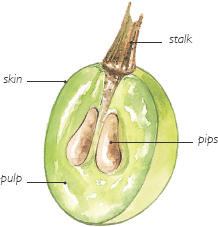
The juice, or squeezed pulp, of the grape contributes water, sugar, acids and flavour compounds, but it is not the only ingredient of wine. Colour, tannins and flavour compounds also come from the skins, and, depending on the type of wine, some tannin may also come from the stalks. The pips contain bitter oils, and modern winemakers avoid crushing them.
Other shapes
While the standard stainless-steel vat and oak barrel are not about to disappear from wineries, other shapes are finding favour, usually because they can help in producing ever-more silky tannins. Conical fermentation tanks for reds are popular, in wood or steel; upside-down cones can also be found; again, it is said that they give very gentle extraction. Concrete is enjoying a major return to favour: the new winery at Château Cheval Blanc consists of 52 curvy concrete tanks (for 40 parcels of vines: that’s luxury).
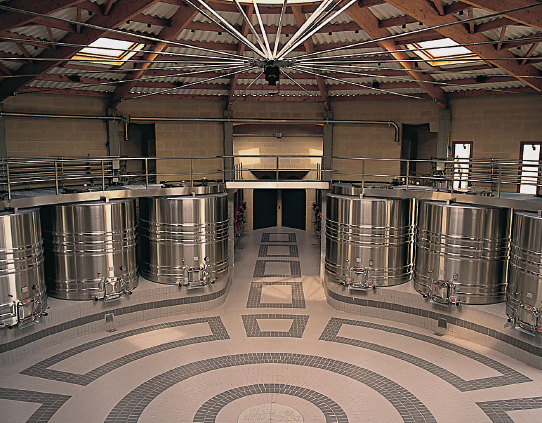
The red wine fermentation chai at Domaine de Chevalier in Pessac-Léognan, Bordeaux. The post-fermentation maceration also takes place in steel vats like these at most estates; the wine is often run into barriques for the malolactic fermentation.
Carbonic maceration
If you want light fruity reds, bright in colour and low in tannin, this is the process to use. It is most usually associated with simple Beaujolais – a wine which fits the above description perfectly – but the process is used in many parts of the world, on a wide variety of grapes. Serious cru Beaujolais is not normally made this way.
It involves putting whole clusters of grapes, uncrushed and unbroken, into a closed fermentation vat, and smothering the lot in carbon dioxide. With oxygen excluded, an intracellular fermentation takes place within each berry which, apart from producing some alcohol, also produces aromatic compounds and glycerol, and reduces malic acid levels. This sort of maceration may continue for between one and three weeks; usually the grapes are then pressed and a normal fermentation completes the transformation of sugar into alcohol.
In practice, events are never quite this clear-cut. The weight of all those grapes tends to crush the ones at the bottom, so that the juice runs; it is only the grapes at the top of the vat that undergo a pure intracellular fermentation. Nevertheless, the wines have a characteristic aroma and flavour of bananas or bubblegum that can be very attractive. Such wines are intended for drinking young.
Even if it’s not actual carbonic maceration, similar principles apply to reds made by whole cluster fermentation anywhere in the world. Even if the vat isn’t doused in carbon dioxide, this gas will be given off by the fermentation of the juice at the bottom of the vat, and will have the effect of excluding some or all oxygen at the top. If any winemaker uses whole cluster fermentation, he’s doing it to get bright, forward fruit flavours into the wine. It can be very successful with varieties like Tempranillo and Carignan. Some serious Burgundy producers, and Pinot Noir producers elsewhere, as well as some Syrah producers, use a proportion of whole bunch fermentation, for reasons of texture, and also for a particular sappy, almost green, herb-scented flavour from the stems which adds a fascinating complexity to the wine.


Oaked wine has not necessarily seen the inside of a barrel. Other and cheaper forms of oak (above) include granular virgin oak, oak beans or cubes, and oak chips, with different toast levels. These can be dunked into fermenting wine to give some new oak flavour. The traditional way is by aging the wine in new oak barrels, which are shaped and toasted over a fire, like these (left) at the coopers Tonnellerie Lasserre in the Bordeaux region. The precise degree of toast will have been specified in advance by the buyer of the barrel.
Carbonic maceration is not used for white wines, which acquire pretty strange flavours if treated this way.
Malolactic fermentation
This secondary, bacterial fermentation changes the sharp-tasting malic acid in wine to the riper-tasting lactic acid and is almost universal in red wine. It does not reduce the total acidity in the wine, but makes it taste less aggressive, and adds to the wine’s apparent weight in the mouth. In white wines it may give a creamy, buttery flavour, but will certainly soften the wine and reduce the up-front fruitiness. A winemaker can decide to put all, part, or none of his wine through malolactic fermentation, depending on the flavour he wants.
The effect of oak
Wine may be stored in a variety of materials, including stainless steel, concrete, fibreglass and wood. (Wood usually, but not always, means oak; in Savennières in the Loire, for example, chestnut and acacia are traditional. Italy also uses some chestnut. Austria and Croatia use some acacia.) In most of these, except in wood, the wine, if it is kept at a low temperature and not allowed to oxidize, will not change or develop, and will retain its youth and freshness. Indeed, one Sauternes estate, Château Gilette, keeps its wine in concrete vats for up to a couple of decades before bottling it. At bottling the wine tastes almost as young as it did when first made.
But aging in oak barrels is different. First, there is a small exchange of gases through the pores of the oak; this slow oxygenation softens the astringency of the young wine and reduces the fresh primary aromas. Old oak barrels, which impart no flavour of their own to wine, are sometimes used to achieve this.
New oak barrels also give certain flavours to wine, most obviously vanillin. This has a delicious affinity with the flavour of some grapes, notably Cabernet Sauvignon and Chardonnay, and these are often aged in small new oak barrels (usually 225-litre barriques, often known as barriques Bordelais simply because they are the size traditionally used in Bordeaux) for maximum oak flavour. If overused, however, new oak can dominate the flavour of the wine and make all wines taste alike.
BLENDS VS. VARIETALS
It is a fact of modern wine that while consumers like varietal wines (those made from a single grape variety), winemakers often find blends more interesting – the reason being that a good blend is more than the sum of its parts, while only a few grape varieties are interesting enough on their own to produce complex, profound wines. Many authorities believe that no matter how good a varietal wine is, 5 per cent of another grape will always make it better. Blends are a useful way of hedging your bets in regions like Bordeaux, where not every variety can be relied upon to ripen perfectly every year.
De-alcoholization
Winemakers are struggling with rising alcohol levels caused by warmer summers, vigorous vines and long hang times. Too much alcohol means less aroma, and heavy, hot-tasting wines. There are two basic techniques for removing alcohol from finished wine: one is the spinning cone, which uses centrifugal force; the other is reverse osmosis. Wine can be balanced at more than one level of alcohol; but in removing alcohol you are also in danger of removing the esters, aldehydes and organic acids that give aroma and flavour. To solve the problem at source, in the vineyard, is the better long-term solution.
French oak generally imparts less strident flavours than American oak, though American oak treated in the same way as French (air dried rather than kiln dried; split rather than sawn) can be reasonably subtle, and the handling of American oak has improved. (French oak barrels are also approximately twice the price of their American equivalents.) Oak from Minnesota and Wisconsin is much used, though some winemakers find it too tannic; Oregon oak is now beginning to be used, though only on a small scale so far. French oak may come from a variety of different regions: Limousin oak is wide-grained and tannic and often used for brandy; Tronçais, Allier and Nevers is tight-grained and much used for wine; Vosges, too, is tight-grained. Oak from Slavonia in Croatia has long been popular with Italian producers, who favour it for their large old casks. German oak, which can give a spicy note, may also be used, and Russian and Hungarian oaks are making a reappearance.
But it is not just the oak that imparts different characters to the wine: the choice of cooper is equally important. Winemakers experiment with different coopers, and settle on those most suited to their wines, just as much as with different oaks.
And then there is the question of toast. All barrels are bent into shape over a fire, and the fire inevitably toasts the inside of the barrel. Barrels given a heavy toast impart a spicy, toasty, roasted coffee flavour to wines, but give less oak flavour because the toast acts as a barrier between wine and wood tannins. Barrels with a medium toast will create wine with more tannin and vanilla; barrels with a light toast will impart more tannin again.
Obviously, the smaller the barrel used the greater the effect of the wood on the final wine. The most common size is the 225-litre Bordeaux barrique but this is beginning to lose popularity in favour of the 500-litre barrel as consumer tastes move away from profoundly oaky wines. The Burgundy pièce is slightly bigger, at 228 litres, and while most regions have their speciality sizes, few producers in Chablis still use the traditional feuillette of 132 litres.
Traditional German barrels are the Mosel’s 1000-litre Fuder and the Rhine’s larger 1200-litre Stück. Italian botti come in various sizes, as do the pipes for aging port in Portugal. In Australia hogsheads are commonly 300 litres, but nobody is bound by tradition these days and winemakers choose their barrel sizes according to the effect they want the wood to have on their wine style.

Botti and barriques – the old and the new at the Giordano winery in Valle Talloria d’Alba in Piedmont, Italy. Piedmont’s powerful reds used to be made solely in big botti casks, then there was a big swing to barriques, which threatened to swamp the individuality of the wines, and many of the best estates now use both.
New oak barriques have another effect as well: they help to fix the colour of red wines, and polymerize the tannins. (In other words the molecular chains of the tannins are lengthened so that the tannins taste softer.) The sooner the wine goes into barrique, the better: the malolactic fermentation is often done in barrique for this reason. Oak chips or oak staves have the same effect of fixing colour and polymerizing tannins; in addition, if chips are added during racking they reduce the necessity of adding sulphur dioxide, since they actively protect the wine against oxidation. They also give a touch of oak flavour, but they can’t imitate the oxidative effects of proper barrel aging. Oak chips are generally illegal in Europe for appellation contrôlée wines or the equivalent – which is not the same thing as saying they are not used.
Co-fermentation
This is an old Rhône habit being enthusiastically adopted in the New World. Also called co-pigmentation, the practice involves fermenting a few white grapes with the red. It still happens in Côte-Rôtie, in the Rhône, where a tiny per cent of Viognier may be added to Syrah – but it is not the same as blending white wine with red. In Côte-Rôtie the red and white grapes must be fermented together, and this could be crucial. It seems that if a red fermentation has what are called ‘co-factors’ added before fermentation, then these co-factors may produce extra colour. Paradoxically, these cofactors may be found in certain white grapes. Yalumba of Australia, which is researching co-pigmentation, thinks that quercetin, flavonoids and procyanidins from the skins and pips of Viognier are just such cofactors – and that if you add Viognier to a Shiraz ferment you get more colour than you would from Shiraz on its own. The colour also seems to be more stable over time, mouthfeel and texture are enhanced, and flavours and aromas are more vibrant. In South Africa, Radford Dale has co-fermented Cabernet Sauvignon with Chardonnay, half and half, for an impressively dark, silky wine of great finesse. There are also South African experiments with co-fermenting Pinotage or Malbec with Viognier.






















































